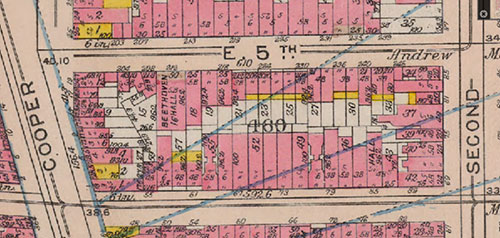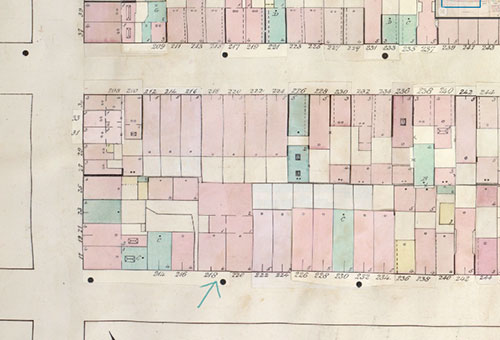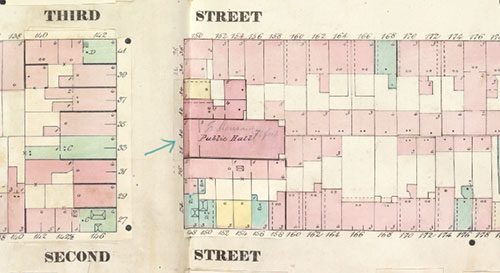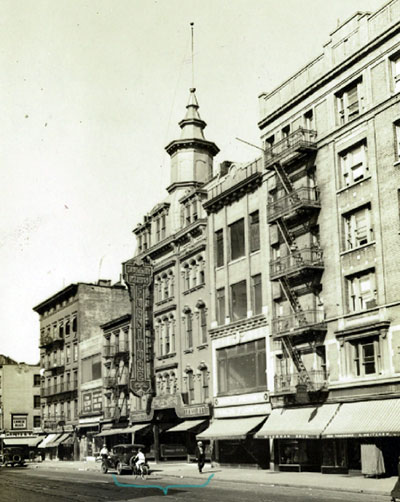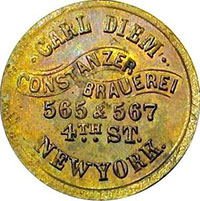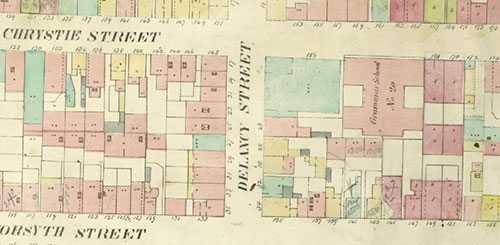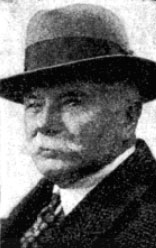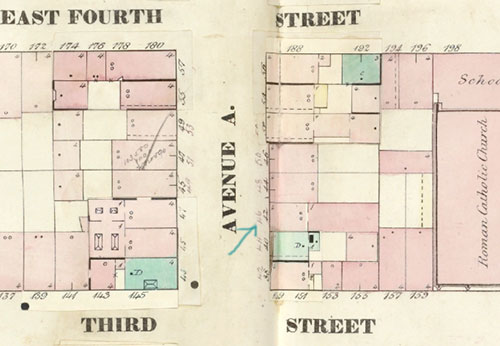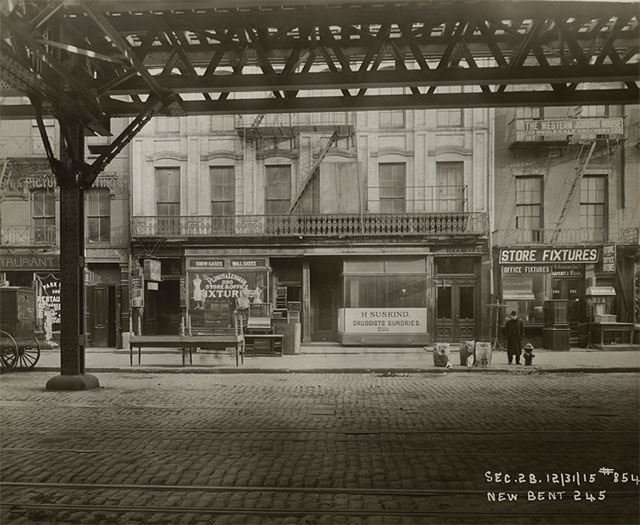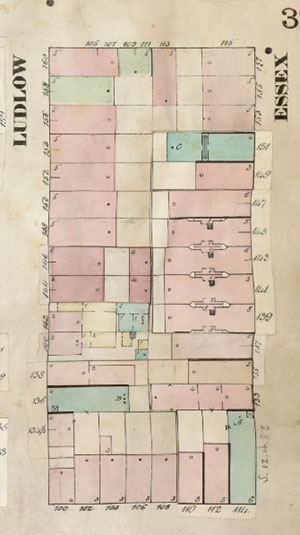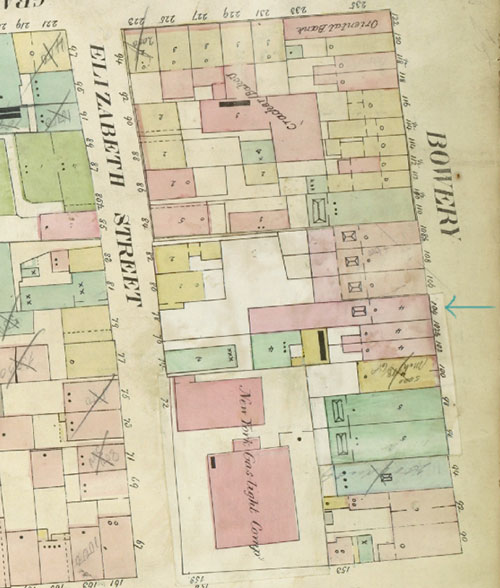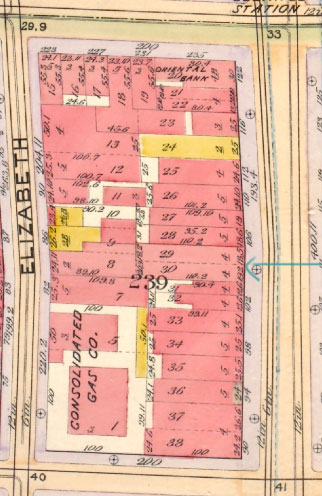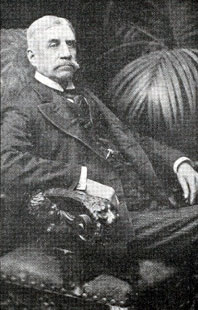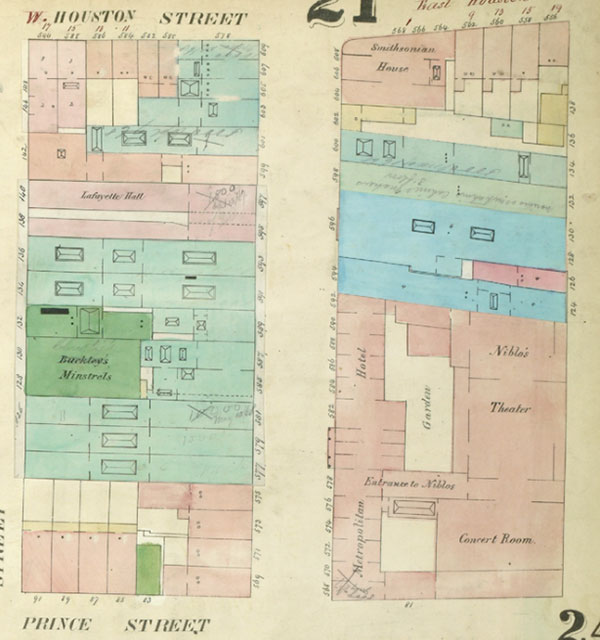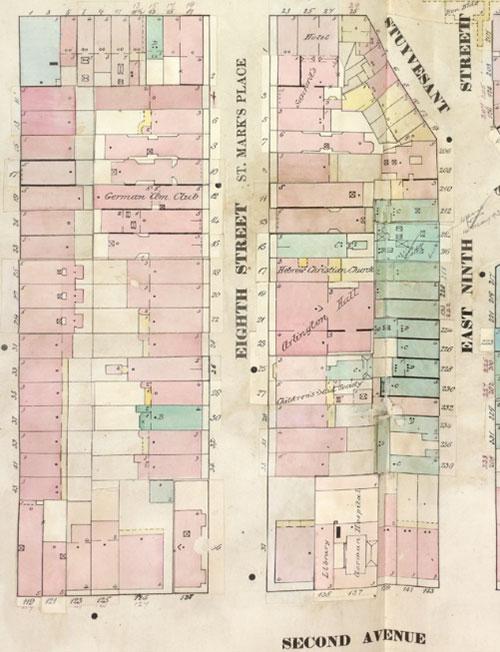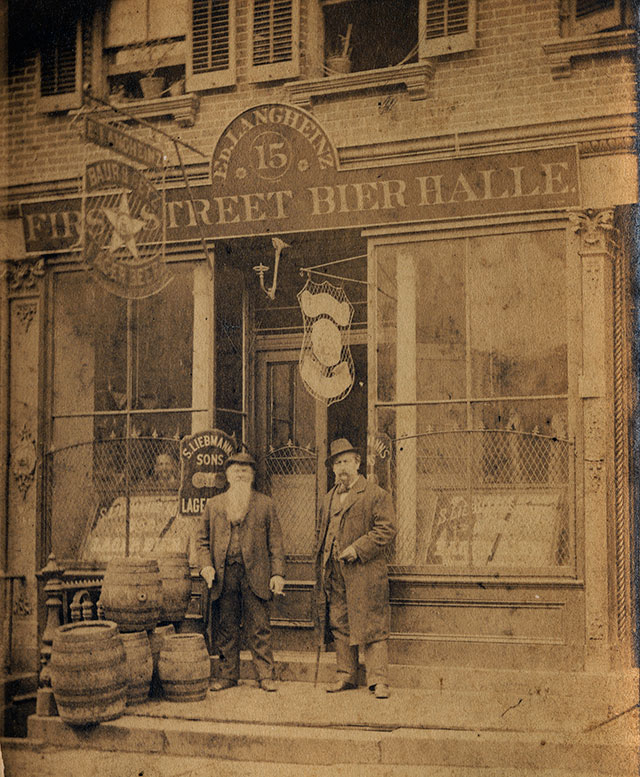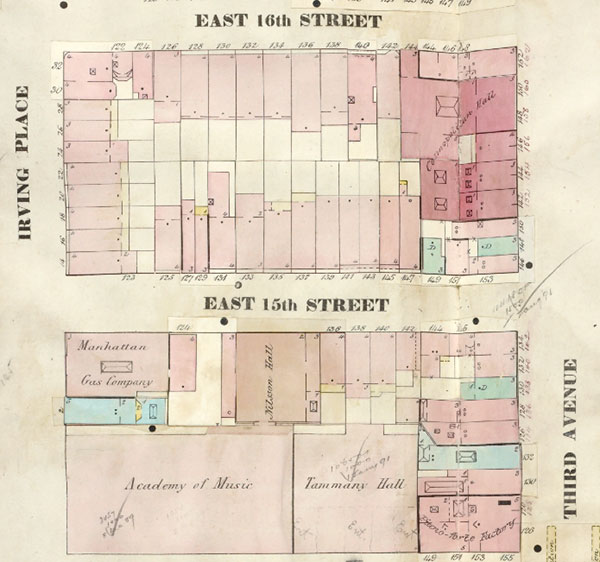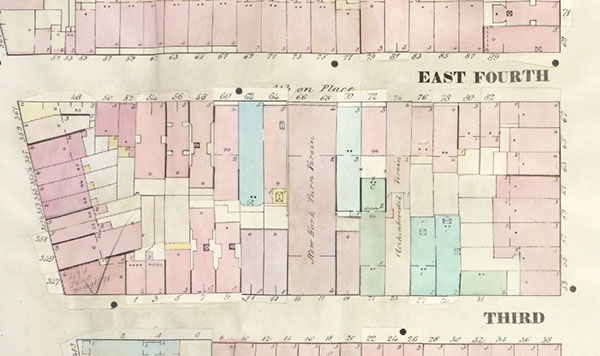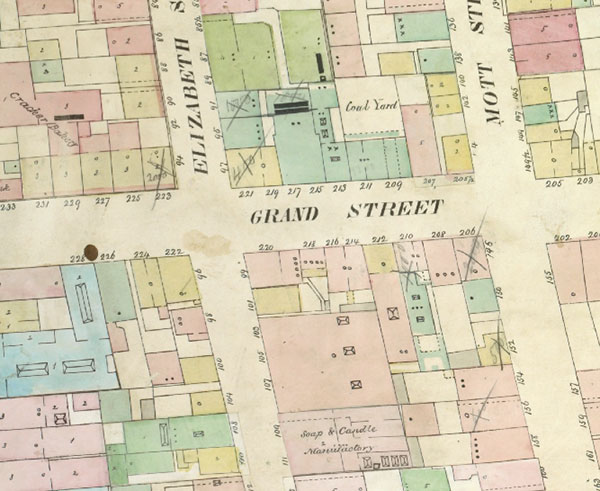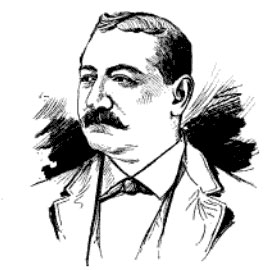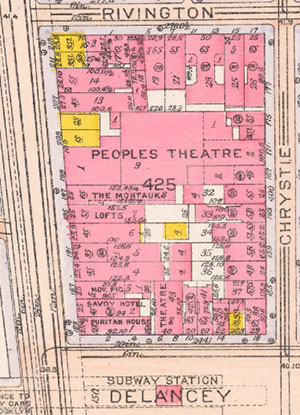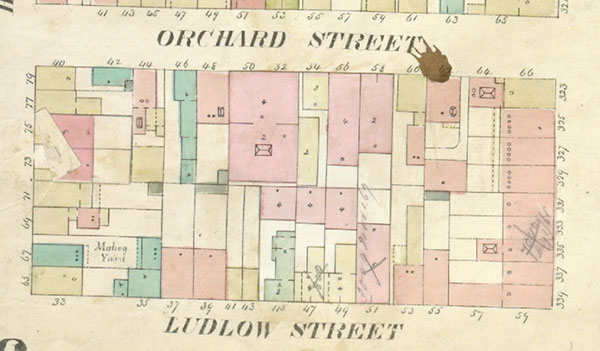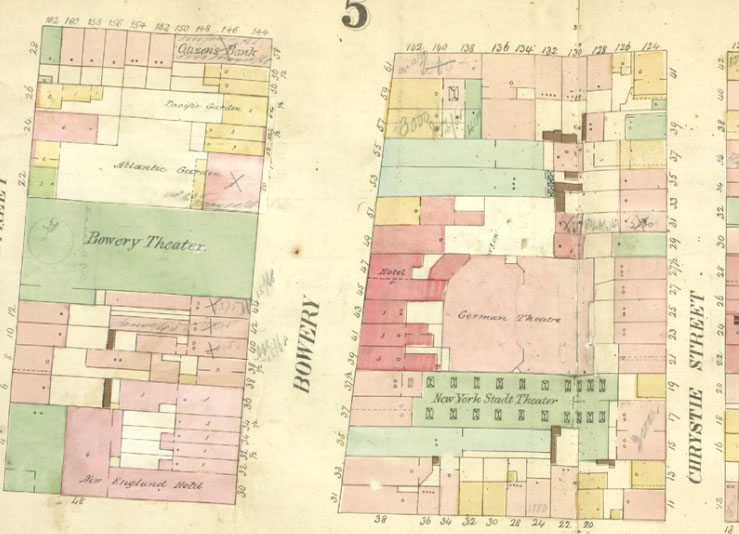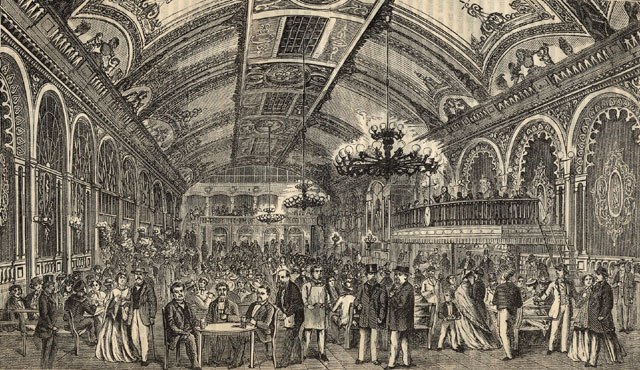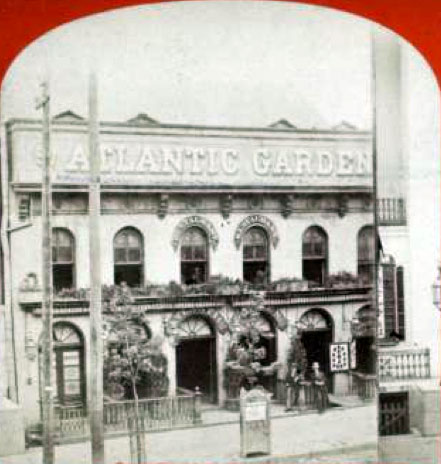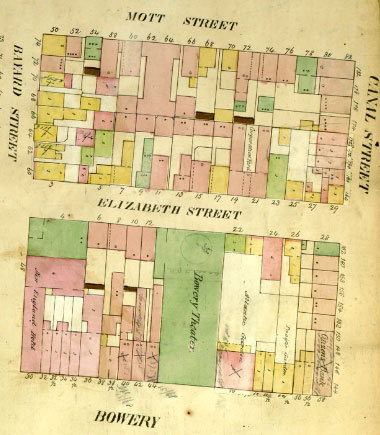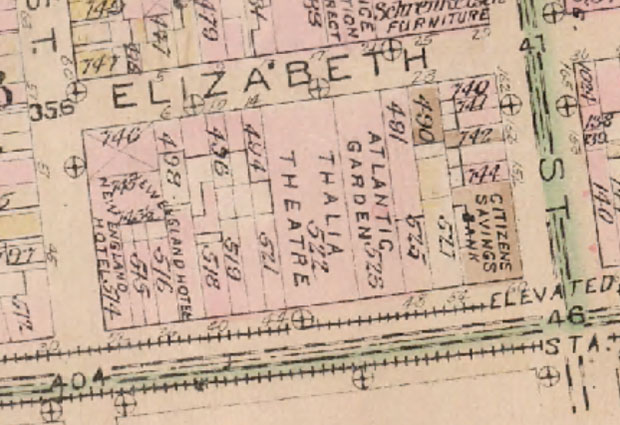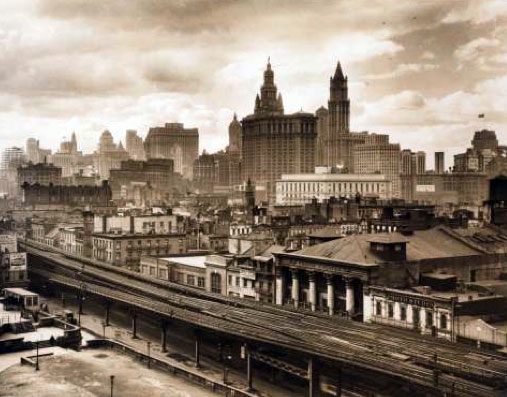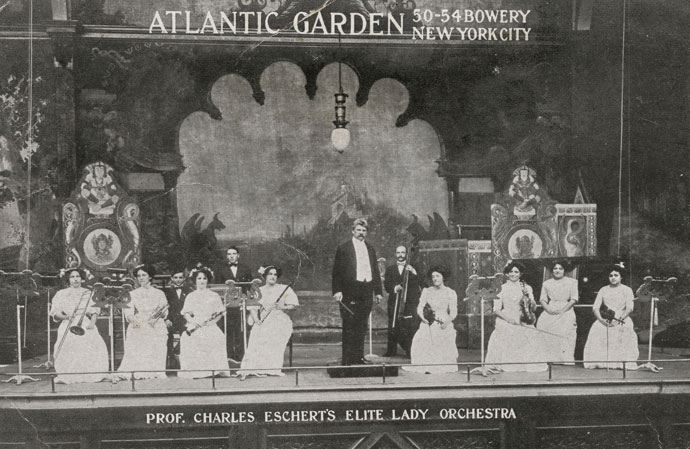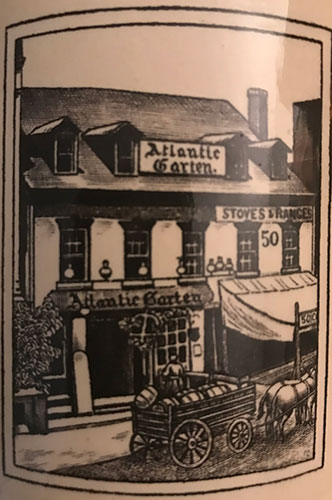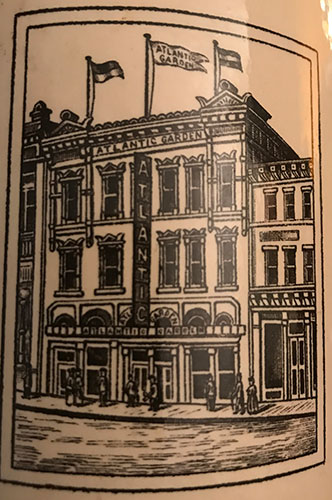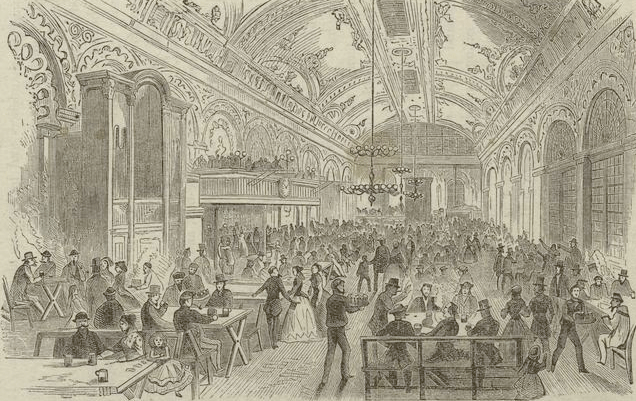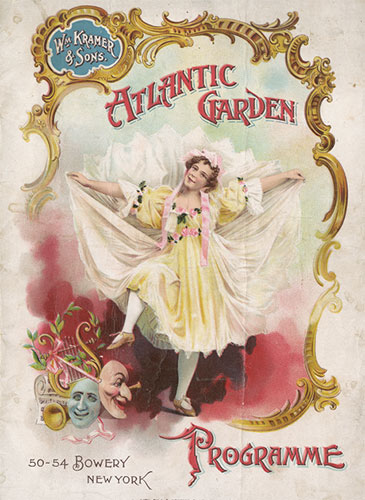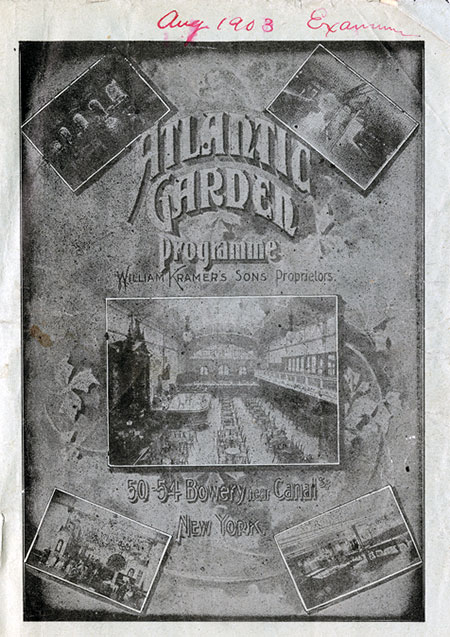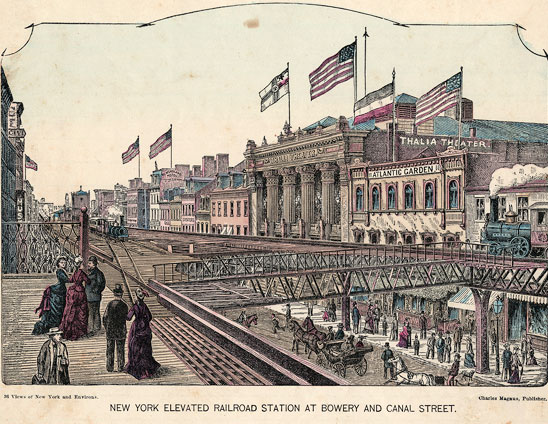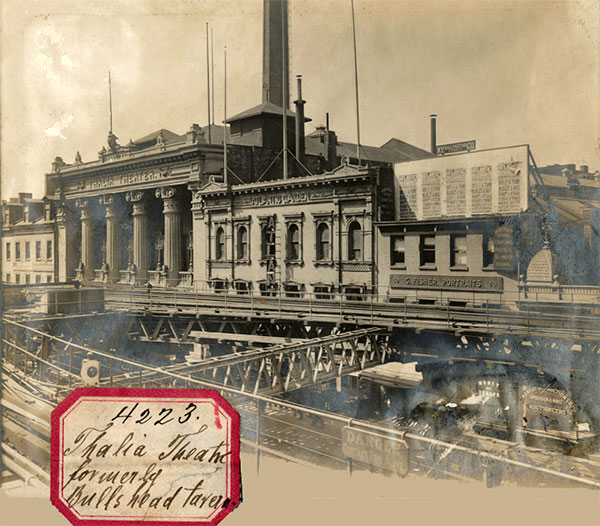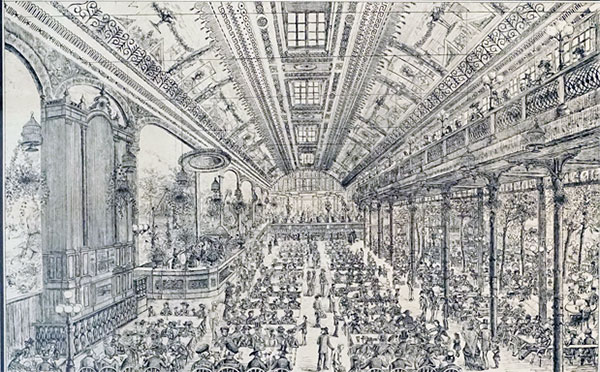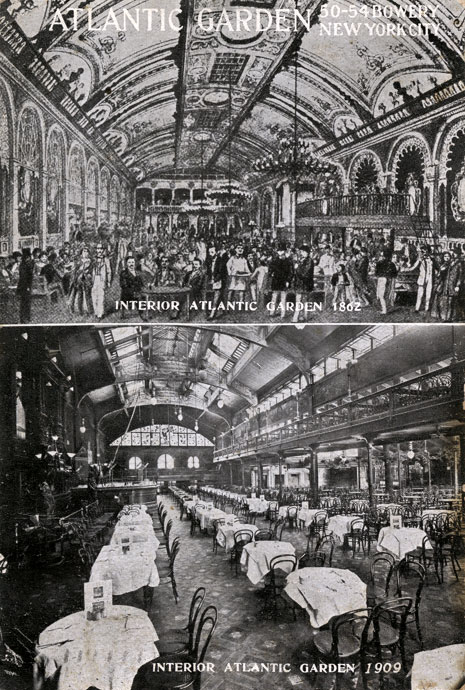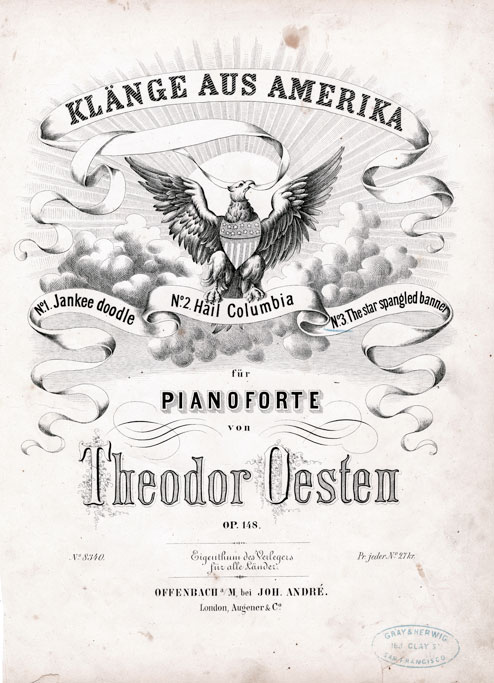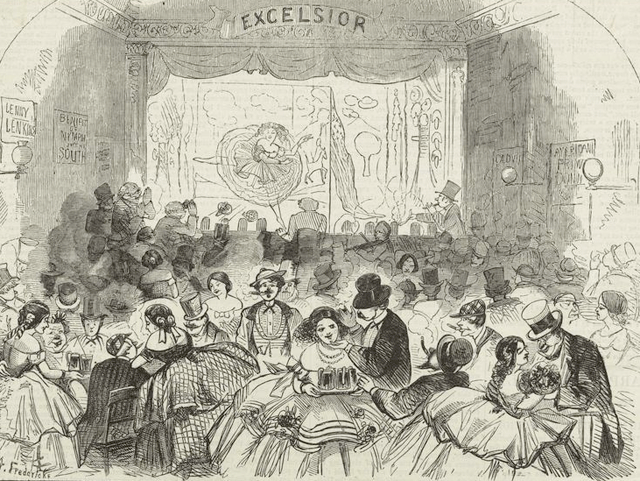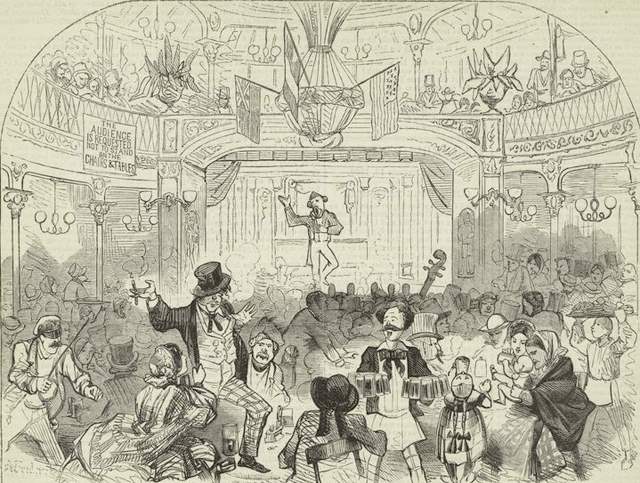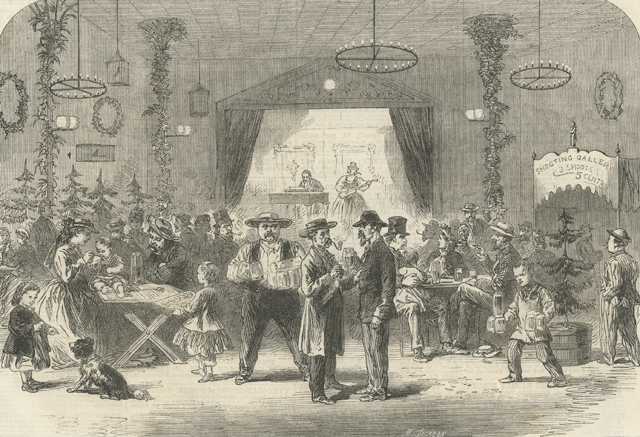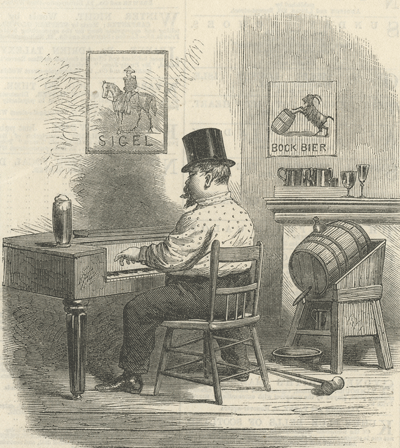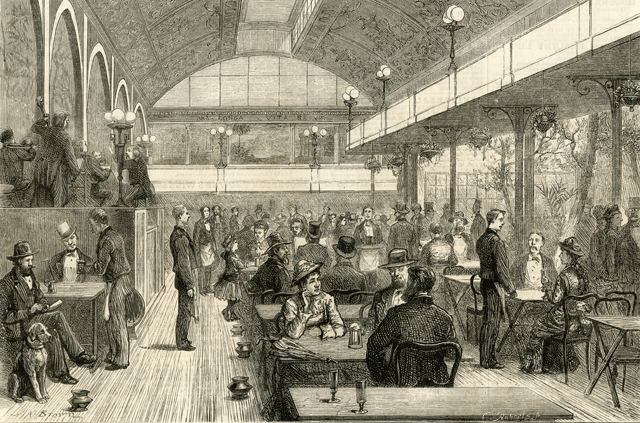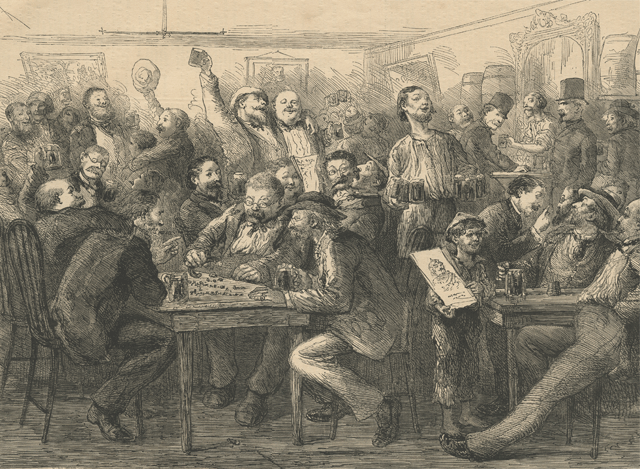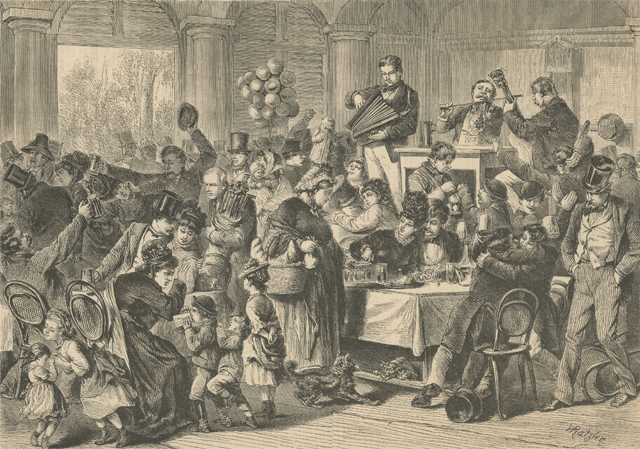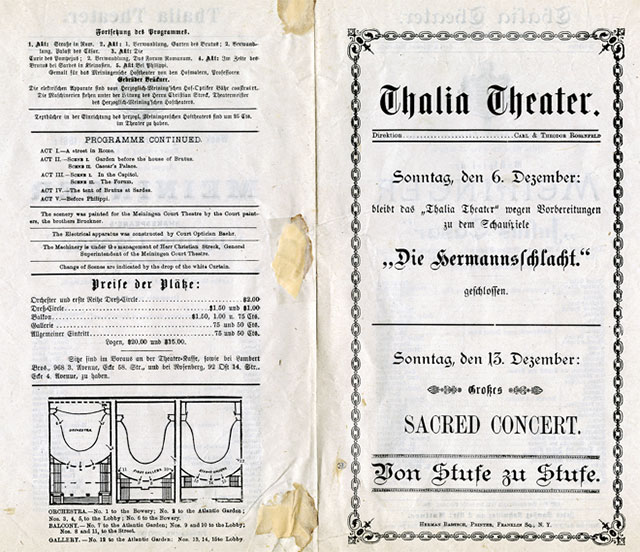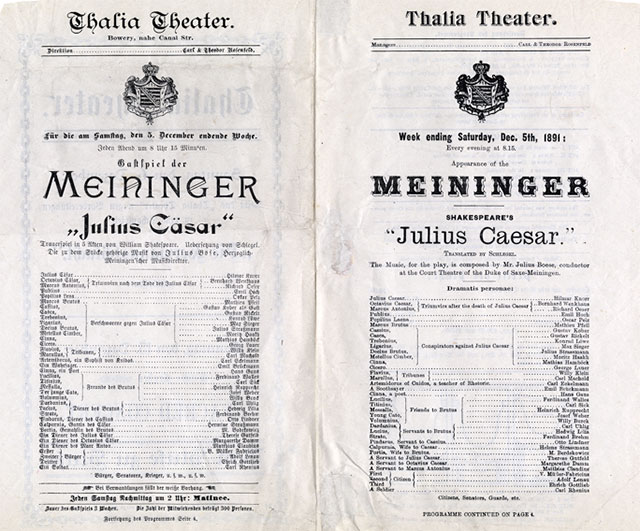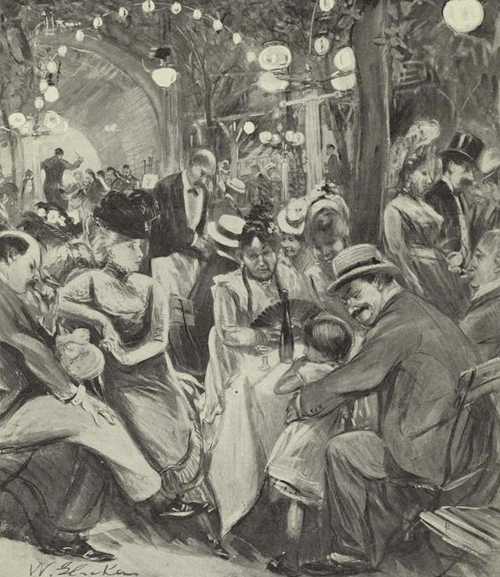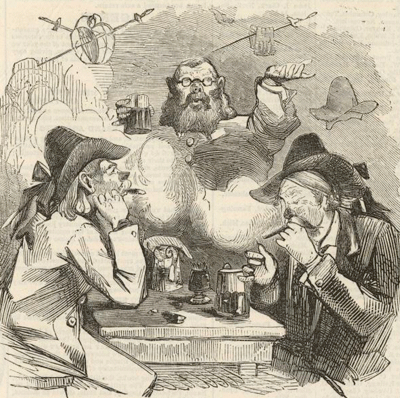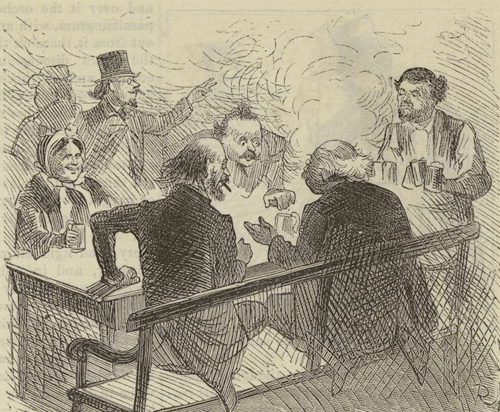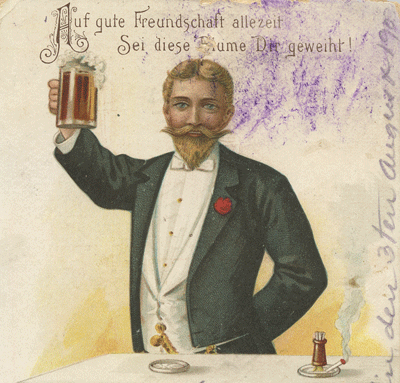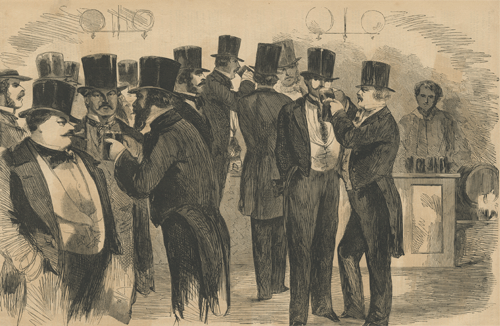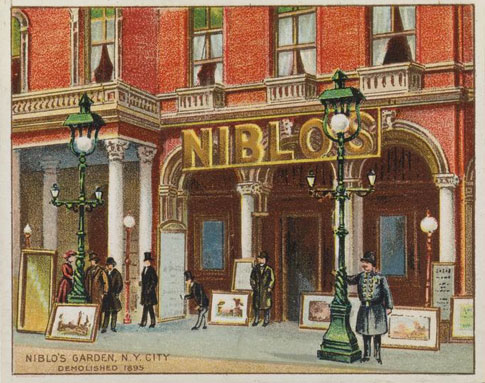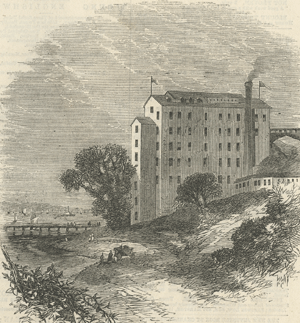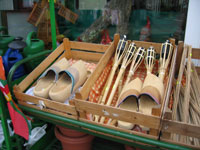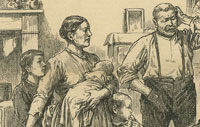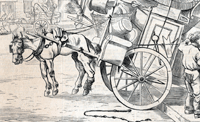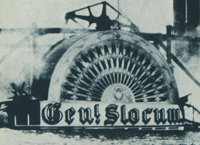Drinking establishments in Kleindeuchland fell into three categories.
-
Basement or celler bars which catered to the rougher elements and often offered prostitutes.
- A local saloon where respectable workers could go for a drink.
- Family places like the beer gardens where the whole family went to drink, sing and be entertained.
Beer Gardens
The beer garden was an important part of German America life. People worked 6 days a week and it was in the beer gardens that the entire family congregated on Saturday afternoons and Sunday evenings to eat, socialize, sing and drink beer. There were numerous of these establishments throughout the German American neighborhoods in the New York Metropolitan area - Jersey City, Hoboken, Brooklyn and lower Manhattan. Some were very large and could accommodate up to 1,000 people. Music, smoking and beer drinking were the most important components of the beer garden, but many also had other types of entertainment. Everyone, "even the baby is sure to be treated to a modicum of the ruddy malt." [The Illustrated London News, Dec 3, 1864]
German Americans were very family oriented. Germans parents rarely went out without their children. Entertainment, diversions and holidays were for the whole family.
"In 1853 one of the popular summer gardens on the Bowery was the Vauxhall, just opposite Peter Cooper institute on Forth ave. Opened in 1806 the stars of its first bill were Mr. and Mrs. Edgar Allan Poe, parents of the poet, whose performance, according to the contemporary reviews, "showed not too much talent". Later the Vauxhall became the headquarters for P. T. Barnum's curio and variety show - forerunner of vaudeville. About the same time (1852) Edward P. Christy, famous minstrel man, opened White's Varieties at No 17 Bowery. Garden theaters and concert saloons, as they were called, continued to multiply along the street. Among the more famous was the Atlantic Garden at 50 Bowery, where German plays, "Orchestrion" concerts and solo singers drew family groups for years. Other such places of entertainment were the Liberty (later the National) Garden at 104 Bowery, the Pacific Garden at No. 54 and the Theater Garden at No. 78. Most of them seated over a thousand persons."Some Beer Gardens in 1859The Evening Independent Massillon, Ohio 17 August 1948
The New York Sabbath Committee, a temperance group very much opposed to Sunday beer drinking, listed several theaters and their performances of dramatic entertainment, comedies, singing, ballet band and orchestra music (both "classical" and newly composted), as an example of the corruption of the Sabbath by the beer halls. They claimed the list of examples of the entertainment was the "most just and impressive method of bringing the evil in question to the knowledge of the reader." The theaters listed were: New York Stadt Theatre, 37-19 Bowery - Kmuschka's Concert Hall, Ave A (With Serious and Comical Duetts, and Solos, and Band Music) - Constanzer Brewery, 565-576 4th street - Buson's [Busam's] Fortuna Hall, 220 Second Street - Harmony Gardens, 139-145 Essex street - Central Hall of Social Reformer, 28 Grand Street - Eustachi's Volk Theater, 4th street - Tulp's Thalian Hall, Ave A - Germania Hall, 42 Ave A - Metropolitan Hotel. Strauss was a popular component of the entertainment.
Halls and Assembly Rooms
Lower East Side German societies of various types (singing, shooting, gymnastic) held annual meetings, dinners, and balls. Occupational organizations also held annual meetings, dinners and balls. In addition, they often held rallies to discuss workers rights issues. There were also numerous political meetings. Veterans of the wars (War of 1812, Civil War) held anniversary events. Holidays such as Carnival, July 4th, Thanksgiving, Christmas and New Years Eve were celebrated with balls. The Lower East Side was studded with Gardens, Halls and Assembly Rooms large enough to accommodate the crowds who attended these events. A look at a few of these establishments gives some idea of the diversity of uses and events among the Germans of the Lower East side between the 1850's to 1900.
Some of the More Popular or Famous Beer Gardens - Meeting Halls
Atlantic Gardens
See below
Beethoven Maennerchor - 210-214 E. Fifth Street
1870: The Beethoven Maennerchor inaugurated a new club House on Fifth street. In celebration the gathered at their old headquarters on 6th street and had a coral performance. They then marched in a procession in a circuitous route through the neighborhood to the new hall. The society was composted of about 300 member of whom 100 were active.
In 1874 The Beethoven Maennerchor gave a children's festival on Christmas evening at its hall on 5th street. There was an illuminated Christmas tree and the children received gifts.
"The Beethoven Maennerchor is one of the oldest singing societies of New-York, and one of the few that have had a continuous life of more than thirty years. It was founded in 1859 by eight young German-Americans, who had the love for the German song as ardently on this side of the Atlantic as in their boyhood days in the Fatherland."New York TimesMarch 17, 1895 - New York Times
1895: In December the Beethoven Maennerchor celebrated the 25th anniversary of the the dedication of its Hall and clubhouse at 210-14 Fifth Street.
1903: The Beethoven Maennerchor sold it property known as Beethoven Hall a four story building at 210 East Fifth Street on a 50 x 96.2 feet plot.
1911 map NYPL digital collection
Buson's [Busan's] Fortuna Hall - 220 Second Street
1854: Francis (Franz) Busam was the owner of the Busam's Fortuna Hall in 1855. When he was naturalized in 1854 in the court of Common Pleas, he gave his address as 260 Second Street and he renounced the Grand Duke of Baden.1855: "The Germans of the Eleventh Ward met last evening, at Fortuna Hall, Second-street, and ratified the Mechanics' Hall ticket."
1855: A New Years Eve ball was held at Busam's Fortuna Hall
1857: Francis Busam, 220 Second, Occupation: Brewer, Publication Title: New York, New York, City Directory, 1857
1858: Second street near ave B - "Bussom's" Fortuna Hall a meeting of the Democrats of the 11th and 7th wards - November.
1861: The Zweibrueckeners had a Thanksgiving festival at Busam's Fortuna Hall "where a rare array of national dishes loaded the board."
1861: October 20 - A German Union meeting was held in the Eleventh Ward, at BUSAM's Hall, No. 220 Second-street (NY Times)
1860 - 1862 or thereabouts : "Busom's Fortuna Hall, 220 Second Street. Sunday, December 11. Great and Extraordinary entertainments by the family Fahn, in the afternoon, 3 o'clock. Dramatic, Humorous Singing Comical Duetts, Dances, etc. in the evening, at 7 o' clock Vaudevilles, Operetta and Farces with songs. Grotesque and Modern Ballet Dancing Entrance Free"
1866: A meeting to ratify the proceedings of the Philadelphia convention was held at Busam's Fortuna Hall Second street, August.
1866: A large Union supporting 12th District political rally was held in Busam's Hall on Second street. September 1.
1866: Excise tax - Busam Francis 220 2nd street, Ret Liquor tax $10
1867: Franz Busam 220 Second Residence Place: New York City, New York, USA Occupation: Saloon Publication Title: Trow's New York City Directory, 1867-68
1867: Francis Busam 220 Second New York City, New York, USA Publication Title: Wilson's Business Directory of New York City, for 1867-68 No occupation listed.
1868: A Thanksgiving Ball was given by the Columbia Scheutzen Corp at Fortuna Hall
1869: Franz Busam, age 49, died May 4, 1869 #33049 Manhattan. Henrietta Goedel Busam, wife, was the designated executor of the estate of Francis Busam who wrote his will February 2, 1864 age 45. He left his personal estate and two lots in ground in Union Hill, Bergen county, New Jersey and potentially an estate from relatives in Germany. He signed the will Franz Busam. They do not appear to have had children. When she died in November 1904 she left her estate to Greenwood Cemetery and two nieces - the daughters of a brother or brothers.
1869: December a meeting of the German Citizen's Association was held at Busam's Hall in Ave B.
1873: Meetings were held in September at Fortuna Hall
1875: Henrietta Busam age 51 was living in Brooklyn.
1880: Henrietta Busam 23 Yates av Brooklyn, New York, USA widow of Francis Busam Publication Title: Brooklyn, New York, City Directory, 1880
1903: The Emanu-El Brotherhood of the Lower East Side held services for a time around 1903 at the Volk's Lyceum at 220 E 2nd Street near Avenue B. (American Jewish History By Jeffrey S. Gurock)
1906: The City Record listed Emanuel Brotherhood at 220 E 2nd street.
Map circa 1868 NY Public Library digital collectionThis section of the map shows 2nd and 3rd streets at Avenue B. 220 E 2nd street is indicated with the arrow. Red building are of brick. Yellow of wood. Green indicates a commercial or other enterprise that may be dangerous for some reason - usually a fire related hazard - perhaps a bakery. White indicates open space. The Fortuna Hall building takes up almost the entirety of two large lots. There is only the smallest open space at the left middle.
Concordia Hall - 20 to 30 Avenue A (East Side
between 2nd and 3rd streets) - The building still stands
See Raines Law andConcordia Hall on Avenue A was a popular place for political rallies and motivational speeches. The building that housed Concordia Hall dates to 1871. I have only included a few of the numerous listing in the papers from 1871 on.
In 1874 Otto Ahrendt was the keeper of Concordia Hall. He was still there in 1877. However by 1880 Hugo Kladivko was running Concordia Hall. Ahrendt was still in the business - he had a restaurant and Tropical Winter Garden at 102 and 104 West 47ht street in 1883.
1871: The German American Teachers association met in Concordia Hall Avenue A in October.
1871: Surviving members of the 20th Regiment of New York Volunteers held an anniversary festival in Concordia Hall 28 Ave A in commemoration of the battle of Antietam fought Sept 17, 1863 in which 41 regiment members were killed and 142 wounded.
1873: A meeting of the Association of German House-owners and tax payers of the 10, 11 and 17th wards was held at Concordia Hall in September to devise a method to deal with the overcrowding in the ward school.
1873: December 8th - The Rhinish Scuetzenbund gave its 2nd annual ball at Concordia Hall.
1874: In 1874 Otto Ahrendt, the proprietor of Concordia Hall at nos 28 and 30 Ave A, was held for $1,300 bail, for infractions of the Sunday laws. Charges were brought by the Society for the Reformation of Juvenile Delinquents.
1874: The Scandalia Quartet club, a singing society, was at Concordia Hall in Avenue B in January 1874, despite the Sunday Laws.
1875: Otto Ahrendt was restrained from having performances at Concordia Hall without a licence.
1877: Otto Ahrendt was the proprietor of the Concordia Assembly rooms.
1877: In October and November cigar makers on strike met at Concordia Hall.
1878: The annual ball of the Separate Troop Calvary took place in Concordia Hall in January 1878.
1878: On Sunday evening November 3 the Concordia Hall on Avenue "B" sponsored two events: A ball for about 300 young people for 35 cents admission upstairs, A variety show downstairs of 10 censt 10 cents admission. Beer was served and the mostly German crowd was orderly.
1879: Separate Troop A Calvary held it annual ball at Concordia Hall 28 Ave A.
1880:
"Company B, Eleventh Regiment, Capt. Freitag commanding, will have its annual ball at Concordia Hall, No. 28 Avenue A, to-morrow evening."1881: Concordia Hall on Ave A was the head quarters of the Republican party for the District.
New York Times, January 11, 1880
1880: The Peter Albers Association ball was held in Concordia Hall a German resort kept by Hugo Kladivko in Avenue A near Second Street.
1880: October 15, Naturalization of Hugo Kladivko restauranteur 14 Avenue A, denounced the Emperor of Austria.
1880:
The German and Hungarian musicians of this city are going to have a "gay and festive" time on the 9th of this month. Hugo Kladioko who formerly kept the Hotel Liszt, on Fourteenth Street, next to Steinway Hall, has moved over to Avenue A, and though that neighborhood is one of the most unfashionable in the city, to put it mildly, his friends have not deserted him. Concordia Hall is part of his establishment, and there he is going to give an "artist's" ball. The committee comprise Rafael Josefiy, Max Vogrich, August Wilhelmj, Ad. Neuendorf, Dr. Damrosch. Edouard Remenyi, Rudolf Bial and other well known musicians. Fraulein Geistinger, Cottrelly, and Jaunischowsky will be among the guests, and Mr. Kladioko is making great preparations for the reduction of various national dishes to be washed down with lager beer and Hungarian wines. Every ticket entitles the holder to a carriage to and from the ball. If there will not be a good time at that ball, I am no judge. With two such leading spirits as Wilhelmj and Remenyi at the helm look out for fun.1881: An artist ball was given in Concordia Hall in February. The proprietor was Hugo Kladivko. The establishment had a superior dancing floor, excellent dressing room and a large gallery. It was beautifully decorated.Musical Record and Review, Issues 105-156
1882: In April the Republican Association of the 10 Assembly District met at Concordia Hall Avenue A. "A resolution was passed approving the veto of the Anti-Chinese bill." Chinese Exclusion Act (1882)
1884: February 17 and 26, Cigar workers on strike held meetings at concordia Hall.
1885: Listed at Avenue A between 2nd and 3rd streets when the Cigar Makers Protective Union held a ball there in March.
1888: In support of the brewers strike the metal workers and food producers associations met at Concordia Hall.
1889: Real Property for sale at auction
"The most important was of "Concordia Hall," Nos. 28 and 30 Avenue A. It was offered under foreclosure to satisfy a third mortgage on which over $35,500 is due and bids were taken over the first and second mortgages which aggregate $50,000. The first bid was $1,000 over said mortgages and the last $24,500, or a total of $74,500. The name of R. S. Newcomb was given as the purchaser, but the real buyer is Moritz Bauer, defendant in the foreclosure proceedings.1891: Speeches were given at Concordia Hall in October 1891.Real Estate Record and Builders' Guide, Volume 44
1895: Germany American political meeting held at Concordia Hall 28 to 30 Avenue A.
1896: Large numbers of citizens of the Lower East side met at Concordia Hall to protest the passage of the Raines liquor bill.
1899: Otto Ahrendt was arrested and taken to the Jefferson Market court where the judge protested that he did not understand why the police spent so much time and energy prosecuting excise violations when there were so many worse crimes being committed. Otto Ahrend had a licence to run a hotel but not to serve beer and have music. The judge said that any decent hotel would serve beer and have entertainment.
1899: In 1899 it was proposed to convert the Concordia Hall into a court house. At that time it was described:
"The large room is fairly lighted, at the easterly end, by windows opening on the yards of the adjacent lots, and at each easterly corner by windows opening on light shafts; on the Avenue A end the light is ample. There are two ventilators in the ceiling. So long as the adjacent lots remain as they now are, the light and ventilation will be sufficient, but, this being an interior lot, the possibility of adjacent owners building up to rear lines of their property ought to be considered. This being a tenement district, it is not probable that such buildings will be erected, but the possibility should be provided for, if a long lease is itentered into."Proceedings By New York (N.Y.). Sinking Fund Commissioners
Map circa 1868 NY Public Library digital collectionThis section of the map shows Avenue A between 2nd and 3rd streets. 28 - 30 Avenue A is indicated with the arrow. Red building are of brick. Yellow of wood. Green indicates a commercial or other enterprise that may be dangerous for some reason - usually a fire related hazard - perhaps a bakery. White indicates open space. The hall takes up all of the available space in the double wide lot. The footprint of the building is the same today.
NY Public Library digital collectionAvenue A between 2nd and 3rd East Side 1933. Concordia Hall is the building with the spire and the long street sign.
Otto Ahrendt
Otto Ahrendt was the proprietor of the Concordia Beer Garden in 1874.
1870: Ward 17, 1st between 1st and second ave., Shrendt, Otto age 29, LB Saloon born Germany, Rosa age 20
1870: Otto Ahrent was listed twice in 1870. Ward 17, Ahrendt, Otto age 29 Beer Saloon $1,000 born Berlin, Rosa age 20 born Wurtenberg, Schmit, Mary age 20 , servant
1872: Otto Ahrendt 43 First Occupation: Beer Publication Title: New York, New York, City Directory, 1872
1877: Otto Ahrendt 30 Av A New York, New York, USA Occupation: Beer Publication Title: New York, New York, City Directory, 1877
1880: According to his 1880 passport Otto Ahrendt, age 38, born Berlin, May 12 1841 a naturalized citizen of the United States, was five feet six inches tall with blue eyes and light blond hair
1880: Otto and Rose went to Germany and returned on the Westphalia, 15 September 1880, occupation merchant, Cabin Class, from Hamburg to New York, five pieces of luggage
1883: By 1883 Otto Ahrendt had a restaurant and Tropical Winter Garden at 102 and 104 West 47th street.
1885: Otto Ahrendt was keeping a concert saloon at 102 and 104 West 47th street when one of his waiters was arrested for breaking the Sunday excises law.
1891: No 219 E 76th street n. s. 230 e 3rd Ave, 25x102.2 four story brick tenement ; John H. Boeseenecker to Otto Ahrendt and Rosa his wife, $18,000
1896: Mr. Otto Ahrendt 5 Feb 1896 Age: 51, merchant, U S citizen, Native country, Germany, to New York, cabin class, Port of Departure: Rotterdam Port of Arrival: New York, New York Ship Name: Amsterdam
1900: 8th avenue near West 25th street, Otto Ahrendt 59, hotel keeper, immigrated 1856, Rosa Ahrendt 50, 1 child 1 living, Ottera Ahrendt 7, adopted daughter, Mary Granzow 27, mother of adopted daughter, Guiseppo Aristohle 38, bartender
1915: Queens Otto Ahrendt 74, Mary Ahrendt 43
1920: Wycoff Ave, Brooklyn, Otto Ahrendt 78, born Berlin, retail merchant candy, Mary Abrendt 48, wife
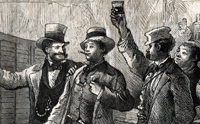
From Singing to Sofas: The History of the Burger-Klein Building for a history of the building.
Constanzer Brewery - 565-576 4th street
Carl J. "Diem's" Thaeter und concert Salon (AKA Carl "Deim's" Loewen-Halle) 301 Houston Street (1858) (Music in German Immigrant Theater: New York City, 1840-1940 By John Koegel, 2009)On August 17, 1858 the day they New York celebrated the success of the Atlantic Telegraph Cable, Alumni of the German University of Jena celebrated the Third Centennial Anniversary of the founding of the institution at the Constanzer Brauerei on 4th street. Many German university graduates attended as well as a number of Americans. "The celebration was kept up in regular German Students' style till a late hour in the morning." (The New York Times)
During the Civil War between 1861 and 1864 there was a shortage of small denomination coins. Tokens worth about a penny were privately minted to be used in lieu of government coins. Undertakers, saloon owners, butchers, beer hall owners and others minted their own tokens. The token pictured here was issued by Carl Diem of the Constanzer Brewery at 565 & 567 4th street.
Carl Diem, born 1826, was listed with his wife Louise age 54 and son Gus age 20, in the 1880 census in New York as a Lager Bier Saloon Owner address West 38th street, born in Wurtemberg.
He was also listed in 1870 age 45, with as a lager bier saloon - value of real estate $15,000 and value of personal property $1,000. He died in New York in 1901 at 323 West 38th street. At the time he was survived by his wife, Louise, his son, and two grandchildren, Paul Arnold Dantel son of his daughter Bertha Louise, and George Karl Diem, son of his son Gust Adolf Diem. He owned the property at 323 and 325 West 38th street.
1857: Carl J Diem 801 Houston New York, Occupation: Liquors
565 4th street was at or near Avenue D.
Eagle Hall - Chrystie and Delancey
1850: October 1860 - Major T. D Smith of the Governor's Guard was the proprietor of Eagle Hall corner Delancey and Christie streets and Military Hall 193 Bowery. In 1850 Military Hall was the oldest and most well established "military rendezvous", for company drills, elections and meetings. Major Smith had just recently finished Eagle Hall which had the largest drill room in the city. The room was also used for balls. He had also refurbished Military Hall. He had "embellished" the bar room covered the floors with "splendid oil cloth". Many military companies held their annual balls at Military Hall.
1851: Swedenborgism - a lecture and debate will take place at Eagle Hall, Delancey street near the Bowery, New York on Sunday afternoon on Swedenborgism and Spiritual Knockings. (Swedenborg (1688-1772) founded a religion in which he believed that the spirit left and body and roamed around during sleep. Hence dreams. Spiritual Knockings were conversations between the living and the dead and were a basic principal of Swedenborgism.)
1853: In December 1853 a funeral for a child was held at 158 Delancey street.
1856: Eagle Hall at Chrystie and Delancey became a Turn Hall.
1857: The Eleventh Regiment rented the Eagle Hall as a Armory.
1858: "Military - To Let from first of May the large drill room 65 feet square with committee rooms attached at Eagle Hall corner Chrystie and Delancey st. in quite at 163 Bowery, from 11 to 1 o'clock or 7 to 8 in the evening."
1858: The Schllerbund Singing Society gave its first public performance in Eagle Hall in 1858.
1861: The Eleventh Regiment Washington Rifles, N. Y. S. M leased the two upper floors of the of Eagle Hall , corner of Delancey and Chrystie Streets, for five years, at a rent no higher than $1,250 per year.
1869: July 25, "The anniversary of the battle of Idstedt during the Schleswig-Holstein war was celebrated by the Sclewsig-Holstein Association at Eagle Hall corner of Delancey and Chrystie streets." On July 25, 1850 the Battle of Idstedt ended the first Schleswig War a military conflict between northern Germany and souther Denmark. 27.000 Schleswig-Holstein troops fought 40,00 Danish soldiers. The Germans did not win the battle outright but gained some concessions form the Danes. The celebration started at 5:00 P. M. the July 25th anniversary. Speeches were given commemorating the battle and the dead. Songs were sung. A general social entertainment followed. The event was attended by both men and "ladies". Many of the men who participated had fought in the battle.
Schleswig-Holstein was under Danish rule from 1846 to 1864.
1869: Armories corner Delancey and Chrystie
1871: October Eagle Hall corner Chrystie and Delancey street was used by the Turnverein a for the Turn School.
1871: Occupied Armories rooms corner Delancy and Chrystie streets (11th Regiment) rent $4,000.
1872: A meeting of the Officers of the 11th Regiment met at the "armory" at the corner of Chrystie and Delancey.
1873: The committee on Armories and Drill-rooms put forth a motion to move the 11th Regiment from its headquarters on Delancey street to Nos 37 and 39 Bowery.
1873: The barkeeper at 26 Delancy, "Nellson Hall", was summoned as a witness in the court martial of of Sergt. Hauser on the 11th Regiment on chartes of mutiny and conduct "prejudicial to good order."
By 1893 The University Settlement was renting a "house" at 26 Delancey street.
Map circa 1868 NYPL digitalThis map is a bit disorienting. Delancey actually runs East West and Chrystie tuns North South. The large building shown in greed is the Eagle Hall. It was on the north east corner of Delancey and Chrystie.
In 1924 the corner of Chrystie and Delancey was described thus:
Beginning at a point on the Northeast corner of Chrystie Street and Delancey Street; running thence Northerly along the Easterly side of Chrystie Street 100 feet; thence Easterly parallel with the Northerly side of Delancey Street 100 feet; thence Southerly parallel with the Easterly side of Chrystie Street 100 feet to the Northerly side 113 of Delancey Street; thence Westerly along the Northerly side of Delancey Street 100 feet to the point or place of beginning. Said premises being known as Nos. 20, 22, 24 and 26 Delancey Street and 154, 156 and 158 Chrystie Street.
Germania Assembly Rooms - 42 Avenue A - 291-293 Bowery
Joseph (Joe) Thum (1858-1837)Established 1859 (Music in German Immigrant Theater: New York City, 1840-1940 By John Koegel)
George Sauer (1827-1905)
George W. Sauer ran the Germania Hall for a number of years. He was a Civil War veteran who served om Company C of the 3rd Calvary known as the German Hussars. He served for three months in 1861.John Stimmel
1860: G William Sauer 32, coal dealer, born Bavaria $500, Louisa Sauer 23 born France, Louisa Sauer 5 Wilhelmina Sauer 2 Emilia Sauer 1/12
1861 - Civil War: George W. Sauer Event Type Military Service Military Beginning Rank Captain Military Final Rank Captain Military Side Union State or Military Term New York Military Unit 3rd Regiment, New York State Militia Cavalry (3 months, 1861) Military Company C Affiliate Film Number 123
1861 - Civil War: July 07,
MEETING OF CAP-MAKERS. --- Yesterday afternoon, a meeting of cap-makers was held at Germania Hall, No. 42 Avenue A. The object of the meeting was to petition Congress to modify and alter the form that contracts for the supply of caps for the Army are given out. It appears that, owing to the number of speculators who are making money out of the misfortunes of our country, and who are in no way connected with cap-trade, the regular cap-makers are unable to earn sufficient to support themselves and families. Before the war commenced, they could earn ten and twelve shillings a day - now they cannot earn more than four. The object of the petition is to ask Government to give the contracts for caps to none but legitimate manufacturers. Mr. J. HOSSLETTER was the President of the meeting; after a short speech from him, wherein he complained bitterly of the [???] of cap-makers, the meeting adjourned sine die."1868:(NY Times)
"The sum of twenty-five hundred dollars is hereby appropriated to be paid out of the treasury of the State, to Major George W. Sauer, in settlement of damages sustained by him upon account of loss of horses, and other expenses, in the year eighteen hundred and sixty-one, in equipping and perfecting a detachment of the third regiment cavalry, National Guard, State of New York, and the Comptroller is hereby directed to draw his warrant upon the Treasurer for the payment to . Major George W. Sauer, of said sum of twenty-five hundred dollars."1868: The Hairdressers Association gave a Thanksgiving Ball at the Germania Hall in 1868.Laws of the State of New York, Volume 2 By New York (State)
1869: Germania Hall 42 Avenue A
1874: Annuel Report of the Adjutant General - Third Regiment Calvary - - Names Major George W Sauer - date of rank Dec. 20, 1867 - residence 291, 293 Bowery New York City - Documents of the Assembly of the State of New York, Volume 2 By New York (State). Legislature. Assembly
1874: In December 1874 Troupe H of the Third Regiment Calvary had its annual ball at the Germania Assembly Rooms. It was well attended by its member and by the National Guard.
1874: Major Sauer of the Germania Halls met with the police Commissioner to discuss the Sunday Blue laws. The rent for the Germania Assembly Rooms at 291-293 the Bowery in 1874 was $25,500 per year. George W Sauer was the proprietor.
1874: On Christmas Day the Saengerrunde (a German volcal group) had a drawing for gifts followed by a ball at the Germania Assembly Rooms.
1876: "Major George W. Sauer", of the Third Regiment Cavalry, celebrated his twenty-fifth anniversary as a member of the National Guard by a ball at Germania Assembly Rooms in October
1877: 2,700 liquor dealers in Manhattan had complied with the law and obtained liquor licenses in 1877. Complaints were leveled against the Police Department for harassing dealers who had filed their applications and paid their money but not yet received renewals because of the paperwork stress at the Excise board. In August Major George W Sauer represented the German Liquor Dealers Association. He was indignant that the government of a "free" county could dictate what a person could eat and drink and when he could eat or drink it.
"It is only here in "Free" America that we see an insolent, overbearing Police dragging innocent citizens and tax-payers to jail because an obsolete law, worthy of the dark ages, has been dragged from oblivion by a legal dicision."In December Major George W. Saner [Sauer] stated that the whole issue of liquor licenses had been arbitrarily and unjustly dealt with.1877: George W Sauer was a member of the Committee of Arrangements who were meeting in May 1887 to adopt resolutions favoring the repeal of the Excise law.
1878: The Germania Assembly Halls was "brilliantly lighted" when the Manhattan Turn society held their first ball of the season in November 1878.
1880: The 1880 census listed on First street, Geo. W. Sauer 51, liquor dealer, Louisa Sauer 43, wife, Emelia Sauer 18 Rose Sauer 15 Tilly Sauer 14 Lottie Sauer 8 Mary Sauer 3 Gertie Sauer 1 Gustav Rubel 29, son in law, musician, Minnie Rubel 19, daughter
August Rubel Marriage 06 Dec 1876 Manhattan, New York, New York, United States Age 25 Marital Status Single Birthplace New York Father's Name Frank Rubel Mother's Name Mary Liebermann Spouse's Name Minnie Sauer Spouse's Gender Female Spouse's Age 17 Spouse's Birth Year (Estimated) 1859 Spouse's Birthplace New York Spouse's Father's Name George W. Sauer Spouse's Mother's Name Louise Veuhn [Kuhn]1883: The New York Times, August 14 - Major George W. Sauer was the Grand Master of the 10th anniversary festival at Sutzer Harlem River Park. See German SocietiesWm. Sauer Marriage 26 Dec 1882 Manhattan, New York Gender Male Age 24 Birth Year (Estimated) 1858 Birthplace New York Father's Name John N. Sauer Mother's Name Margaret Purtell Spouse's Name Rosa Sauer Spouse's Gender Female Spouse's Age 18 Spouse's Marital Status Single Spouse's Race White Spouse's Birth Year (Estimated) 1864 Spouse's Birthplace New York Spouse's Father's Name Geo. W. Sauer Spouse's Mother's Name Louise Kuhn
1895: The Dauntless Pleasure Club held their 5th annual entertainment and ball at the Germania Assembly Rooms, 291 & 293 Bowery, Monday evening January 28, 1895, tickets 25 cents, music by Prof. F. Witt, doors opened at 7:30 curtain rise 8:00 sharp. Stage manager Mr. Wm Kampf. Willaim Kampt, Comedian 179 Second street,
"Parties wishing ot engage Amateur or Professional Talent for Entertainment etc will please address William Kampt, Comedian 170 Second street, New York."(In April 2018 Adam Woodward shared a page from the Journal of the Dauntless Pleasure club.)1896: Civil war Pension invalid, beneficiary Louise Sauer Also in 1905, widow, C. 3 N. Y. S. M. Cav. - No other info.
1896: Brooklyn Daily Eagle, November 19th. A newspaper article about the suspected robbery and murder of a Western gentleman who was found unconscious in a vacant lot on the west side of 8th ave between 152nd and 153rd streets mentions George W. Sauer as the owner of the "Atlantic Casino at 155 street and 8th avenue." According to the bartender at the casino the dead man, Frank P Arbuckle of Denver Colorado, had been drinking whiskey about a hour before he was found. When paying his bill he "displayed a large roll of bills" and had pulled a heavy gold watch and gold chain from his pocket. No money or watch was found when the police arrived. The casino was located at the botom of the stairs at the end of the elevated train line.
1898: New York Times Feb 12, "Atlantic Casino and Other Notable New York Structures Opposite Manhattan Field Go Up in Smoke - &90,000 Damages and Many Narrow Escapes"
Fire destroyed a half a block of frame buildings at 155th street and 8 ave, owned by George W. Sauer. The buildings were: the Atlantic Casino, a hotel owned by John T. Troy, a former baseball player, the quarters of the Polo Athletic Club and the Kessell's summer garden. One of the buildings was the home of George W. Sauer. The fire was covered in papers in Philadelphia and Boston.
1899: Pierceton Record, Thursday, March 2, 1899, Pierceton, Indiana - New York - Maj. George W. Sauer, totally blind, his wife and two daughters, were carried down the fire escape from the fourth story of the Klondyke hotel in a fire panic.
1899: New York Times November 11 - A $30,000 verdict was reversed revising a judgement against the city by George W. Sauer and ordering a new trail. The plaintiff sued for damages to his property at 155 street caused by the erection of a iron viaduct.
1903: The State Sentinel October 14, Seventy-six year old Civil War Veteran George W. Sauer was set to cast his 50th ballot in the up coming elections.
1905: George W. Sauer died March 8, 1905. His obits indicated that Major George W Sauer was with the Third Regiment Calvary. He was active in the German singing society celebrations. In the 1890 he had a place called Atlantic Casino, on 8th ave at 155th street. In 1899 he was blind and owned the Klondike Hotel at 59th street and Broadway where he lived with his wife and unmarried daughter when a fire broke out. He was born September 1, 1827 and died March 8, 1905.
George W. Sauer Event Type Burial Event Date 1905 Event Place Middle Village, Queens, New York, United States of America Photograph Included Y Birth Date 01 Sep 1827 Death Date 08 Mar 1905 Affiliate Record Identifier 147551359 Cemetery Lutheran All Faiths Cemetery
1910: Hull ave. Bronx, Samuel W Crane 54, newspaper reporter, Gertrude Crane 31, Elmer Crane 4, Louisa Sauer 73, widow, mother in law, 13 children 5 living
1913: Louisa Sauer, Age: 77, Birth Year: abt 1836, Death Date: 7 Sep 1913, Death Place: Bronx, New York, USA, Certificate Number: 5369
Flag of George W. Sauer's New York 3rd "Hussars" Cavalry (U.S.) (SOLD in 2007 for 12,500.00 USD)
1870: Johann Stimmel 36, retail butcher, $-5,000 $500, Saxonia, Barbara Stimmel 32, Hesse Darmstadt, Frank Stimmel 3, Jacob Stimmel 10/12, Marie Seibert, age 12, Hesse DarmstadtGREATER ASTORIA HISTORICAL SOCIETY IMAGES Residence of Charles Stimmel, Whitestone Landing1873: Arrival date: 23 Aug 1873 John Stimmel 39, butcher, Babette 37, Jacob 6, Frank age 4, marie 14, Chas 11 Port of Departure: Bremen, Germany, Port of Arrival: New York, New York, Ship Name: Deutschland
1887: John Stimmel was listed as the proprietor of the Germania Assembly rooms.
1880: 1421 2nd ave., John Stimmel 46, butcher, born Saxony, Barbara Stimmel 42, Francis Stimmel 13, Jacob Stimmel 11, Charles Stimmel 9, Edward Stimmel 6, one servant
1890:
PLEASURE SEEKERS DROWNA Rowboat Capsizes and Five Occupants Perish.
A shocking drowning accident by which five lost their lives, occurred recently off Whitestone, Long Island, N. Y. The employes [sic] of the Schaeffer Brewing Company of New York were holding their annual excursion at Stimmel's Pavilion at Whitestone.
While the music and dancing were in progress in the pavilion, a party including JOHN LOGAL, HERMAN HUNG, MARUICE STADLER, MARIE PUNTZ, BERTHA SCHOOP and THERESA LOGAL, hired a boat and started out into the bay. Before they had gone a great distance some persons on the shore were startled to hear the women in the boat screaming. The next instant the boat was soon to upset, and all the occupants were thrown into the water.
An eye witness of the terrible occurrence from the shore saw one of the young women clinging to one of the men, who struggled desperately to keep himself and his female companion above water, when suddenly both threw up their hands and disappeared.
One of the first to go to the rescue of the drowning persons was a son of DR. BLOECKER. He saw one of the young women struggling in the water and seized hold of her as she was about to sink. He brought her ashore with great difficulty.
It is believed that the boat was caught in a heavy wash from one of the Sound steamers which was passing at the time, and that when the boat began to rock the women became panic stricken, suddenly jumped up and caused the craft to capsize.
(The Cranbury Press New Jersey 1890-08-29)
1891: Real Estate Records - Recorded Leases - Bowery Nos. 291-293 Germania Assembly Rooms entire basement and bowling allies under above. John Stimmel to Joseph Thum 5 years from February 21, 1891
1893: July 3, 1896 John Stimmel the proprietor of the Germania Assembly Rooms in the Bowery and the Stimmel's Hotel in Whitestone, L. I. was arrested in Queen's County on an action brought by John G. Grauer a Ridgewood N. J. brewer for failure to pay the balance of a loan. Stimmel was accused of transferring property to his wife to avoid paying the note. The New York Journal
1894: August 26 Brooklyn Daily Eagle Stimmel's pavilion in Whitestone was the destination of excursion boats which landed at Stimmel's privately owned wharf. On the preceding Sunday Stimmel had prepared to receive and feed 2,000 popele. The city trustees were not fond of these excursionists and tried to put and end to it. Stemmil field a suit for &26,00 damages to his character and business reputations.
1894: John Stimmel Residence Year: 1894 Street address: Whitestone L I Residence Place: New York, New York, USA Occupation: Liquors Publication Title: New York, New York, City Directory, 1894
1894: 1894 - Almanacs, American Whitestone House, owned by John Stimmel, at Whitestone, destroyed by fire. November 19
1895: Brooklyn Daily Eagle, August 20, John Stimmel was acquitted for the second time on charges of violating the Sunday excise laws. Two detectives employed by the Good Government club stated they had purchased liquor at Stimmel's picnic park in Whitestone in June. Several other witnesses testified to the same charge. After three hours of deliberation a verdict of "not guilty" was returned.
In September 1895 Stimmel paid a $10 fine for violating a village of Whitestone ordinance prohibiting picnic parties on Sundays. It was pay the fine or spent 10 days in jail. (New York Times)
1898 John Stimmel was granted police permits for masked balls at the Germania Assembly Rooms for March 4 and March 14 1898 fees of $25.
1899: June 16, Charges against John Simmel of Simmel's Pavillion in Whitestone were dropped. He had been arrested on Sunday for breaking the Sabbath by allowing music and dancing at his establishment.
1899: October 16 "Horse thieves visited Whitestone last Saturday night, broke Into John Stimmel's barn at Whitestone Landing and stole a horse valued at $500". A policeman followed the thrives on a bicycle as they walked the horse along. He stopped them and pointed his pistol at them. They put up their hands and surrendered.
1900: 9 Second avenue, John Stimmel 65, butcher, imm 1855, naturalized., Barbara Stimmel 61, 14 children 2 living, Charles Stimmel 29 Anne Stimmel 16
1900: Whitestone, L. I., November 15 The fourth annual ball of the Landing Railroad employes was held at Stimmel's Pavilion, at Whitestone Landing. A train from Port Washington at 8 in the evening brought the guests to Stimmel's and returned to Port Washington "early" in the morning. Professor E. E. Sause's full orchestra provided the music.
1902:
"The Oconee Club, of which Assemblyman W. H. Burns is president, held its sixth annual outing at Stimmel's Pavilion, Whitestone, L. I., last Sunday. (Tammany Times)1903: The Employees of the Lighte & Bros. held their 23rd annual outing at Stimmel's' Pavilion on September 23rd, 1903. "Tickets Admitting Gentleman Only Four Dollars. The crowd arrived on a special train. "The boys" marched to the breakfast room as a lively band played. Clam fritters, fired eels, fish ham and eggs, sirloin steak, veal cutlet, lamb chops, fired mush, boiled and fried potatoes, sliced tomatoes, pickled onions, hot rolls butter, coffee were served. After eating part of the crowd went up to "the grove on the hill" to play cards (pinochle, nep and poker) in a large tent. Others stayed behind to bowl. Others went "yachting". Still others enjoyed games of football, baseball, racing, etc. All enjoyed kegs of beer on tap and soft drinks on ice.At 6 o'clock they rejoined for dinner in the pavilion. The menue included: blue point oysters on the half shell, mock turtle soup, celery, salted almonds, blue fish with white sauce, sirloin of beef, breast of veal, mushroom sause, roast chicken, green corn on cob, green peas, potatoes, sliced tomatoes, potato salad, beets, apple pie, cranberry pie, peach pie, ice cream, cheese, cake, fruits and coffee. The revelers retuned by special train. (American Bottler, Volume 23)
Death: John Stimmel Birth abt 1834 Death 11 Apr 1909 Queens, New York, USA
1909: New York Times April 13, Obit : John Stimmel born Germany circa 1834.
John Stimmel, age 75 born in Germany, died at his home in Whitestone Long Island. He had been well know in the German singing societies and social circles for over 50 years. He had come to the United States as a young man and had built the Germania Assembly Rooms on the Bowery. He was survived by his unnamed widow* and one son, Charles.
*Barbara
1915: Whitestone Queens - Barbara Stimmel 77, head, Charles Stimmel 43, shooting gallery, Anna M Stimmel 17, granddaughter, Phoebe Stimmel 15, granddaughter, Raton Ernst 43, butcher, lodger, Anna Zurick 52, servant, chambermaid, John Zurick 45, servant, gardner, Joseph Yolflolka 20, servant, dishwasher, Henry Fooster 25, servant fireman hotel, James Howard 71, servant bartender
1921: Charles Stimmel Age: 50 Birth Year: abt 1871 Death Date: 30 Jun 1921 Death Place: Queens, New York, USA Certificate Number: 2406
Joseph Thum signed a 5 year lease with the Germania Assembly Rooms in 1891.Joseph Thum was a restaurant owner and famous bowler who organized local bowlers into competitive teams and is considered the father of modern 10 pin bowling.
1889: Joseph Thum 401 G'wich Liquors New York, New York, City Directory, 1889
1891: Thum, Jos. liquors, 292 Bowery, home 48 7th
1891: Bowery, Nos. 291 and 293, Germania Assembly Rooms, entire basement and bowling alleys under "above" John Stimmel to Joseph Thum; 5 years, from Feb.
1894: Thum, Jos. manager, 291 Bowery, h 66 2nd av.
1900: Fulton ave, Bronx, Joseph Thum 42, liquor dealer imm 1876, Frederica Thum 44, married 18 years 1 child, Catharine Thum 17, daughter
1905: Joseph Thum 47, barber, Fredricka Thum 45 Harry Thum 20, clerk Joe Thum 18
1910: Queens, 8th ave., Joseph Thum 52, spot place, own place, Ferd Thum 50, 1 child 1 living, married 25 years
1912: Excise permit Thum Joseph, 1241 Broadway
1921: Passport application Joseph Thum wife, Fredrika Thum of Y City born, Pfullendorf, Baden January 24, 1858 immigrated from Harve thru London to New York in November 1876 naturalized Common Pleas, New York, May 20, 1885. in Germany from June to August 1908, permanent address 82 27th st, Elmhurst L. I., occupation billiards and bowling academy, to travel to Switzerland for three months to visit relatives in distress, sailing on the Orbita May 21, 1921, last pass port obtained from Washington in 1891.
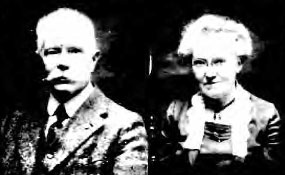
Passport photos of the Joseph and Fredrika Thum - 1921
1925: Queens, Jackson Heights, Joseph Thum 67, bowling alley, Fredrika Thum 65
1930: 84th street, Queens, Joseph Thum 72, $6,000, proprietor bowling & billards, imm 1876, Fredericka Thum 70 Katherine Kuehne 66, widow, lodger
1937: Joseph Thum Age: 78 Birth Year: abt 1859 Death Date: 9 Jan 1937 Death Place: Queens, New York, USA Certificate Number: 369
Joseph Thum, Birth Date: 24 Jan 1858, Death Date: 9 Jan 1937, Cemetery: Woodlawn Cemetery, Burial or Cremation Place: Bronx, Bronx County, New York, United States of America
Find a Grave: Joseph Thum, Death Date 09 Jan 1937, New York City, Queens, New York, United States, Address Hotel Imperial, Bdwy., 131st St., Residence Place NYC, MAN., Gender Mal,e Age 78, Marital Status Married, Race White, Occupation owner, Bowling & Billiard, Birth Date 24 Jan 1858, Birthplace Germany, Burial Date 13 Jan 1937, Cemetery Woodlawn, Father's Name Conrad Thum, Father's Birthplace Germany, Mother's Name Josephine Endres, Mother's Birthplace Germany, Spouse's Name Fredericka Thum
1937: New York Times
"Joseph Thum, proprietor of Thum's White Elephant Alleys, at Twenty-ninth Street and Broadway, who had long been known as "the father of American bowling," died yesterday afternoon in the Parsons Hospital, 35-06 Parsons Boulevard, Flushing, Queens. He would have been 79 years old on the 24th of this month."A star bowler and owner of bowling allies, Joe Thum was born in Baden Germany and had immigrated to the US at age 18. He got into bowling ally business by chance. He was a young man working in a German restaurant at 401 Greenwich street when the owner gave the establishment to him. With his winning ways he turned the restaurant into a big success. Then he "rigged up" the basement with kerosene lamps and build a bare basics bowling alley. The alley became very popular and he organized the United Bowling Club. Subsequently the game became trendy all across the county. In 1895 the American Bowling Congres was formed and the game regularized with uniform rules for pin and alley sizes. In 1901 He opened a bowling ally at 31 and Broadway. Called the White Elepahnt" it contained rows of lanes . He was an active member of many German societies and was a expert rifle shot. He had been in poor health after he returned from Berlin where he had accompanied the bowling team to the 1936 Olympics. He was survived by his widow, Frederica, a daughter, Catherine Beiderbecke, three grandchildren and one great grand child.
Joseph Thum 1937 New York Times
1940: North Elba, Essex, New York Street: Ray Brook Inferred Residence in 1935: New York City, New York, New York Fred Beiderbache 62, owns and operates cabin colony, Catherine Beiderbache 56 Fredericka Thum 80
Thum and Billiards: 1915 - "FELIX ISMAN, INC., leased to Joseph Thum the 2d floor in the southwest corner of Broadway and 31st st."
In February 1915 Thums' Academy at Broadway and 31st street was the site of an exhibition came when an additional billards room was opened. Among the Engineers: "The inspection branch gave a little send-off to C. R. Myer on January 13th, at "Zum Praelaten" with an overflow meeting at Thum's pool room".
1916: "Billiard and Pool rooms will be found in practically all the leading hotels. Among the better known Billiard parlors may be mentioned Maurice Daly's, 1615 Broadway; George F. Slosson's, 1587 Broadway; Joseph Thum's 1241 Broadway" (Rider's New York City and Vicinity} At Thum's pool room in New York City in January 15, 1922 a run of 701 points was made by Edouard Horemans. December 28, 1921 Harry Frisch "scored a comparatively easy victory" over J. H. Van Tassel in a billard tournament at Thum's Academy. (New York Times)
1925 - Thirty-first Street and Broadway Joe Thum's Academy.
1939 NY city Guide - Bowling and Billiards Joseph Thum - 1241 Broadway - Billiards 40cents and hour and up. Bowling 20 cents per game and up.
Fred Bollmer - 42 Ave A
1906: Fred Bollmer committed suicide in his saloon at 42 Avenue A by attaching a tube to the gas jet and putting it in his mouth. He left a note saying he was tired of living and wanted to join his brother, Jacob, who had died. Fred and Jacob had been partners in a saloon at 15th and Avenue A. The article stated that Jacob's wife and child died in the General Slocum disaster and a few months later Jacob committed suicide.Note: Mary Vollmer, age 36, and her children, Joseph age 16, Auguste age 9 and Magdalena age 7 all died in the Slocum on June 15, 1904. Joseph "Vollmer", age 36 committed suicide June 17, 1905, a year after the Slocum. See General Slocum disaster
NY Public Library map circa 1868The footprint of the Germania Assembly rooms is much smaller that Busam's or Concordia. Still it covers every available inch of the lot leaving no yard or open space at all. The church at the right is the Most Holy Redeemer, 173 3rd street, a Catholic church built in 1851. German Catholics were numerous in Kleindeutchland.
Image courtesy Adam Woodward, April 2018291-295 Bowery - December 1915
Left to RightSee Lower East Side Notables
- Picture framing - 295 Bowery - upper floor
- Restaurant - 295 Bowery - (Suicide Hall - Raines House - John McGurk's dive )
- Plinus & Lerhman - store and office fixtures - 293 Bowery
- H Suskind [Harris Suskind] - Druggists Sundries - 291 Bowery
- Western Jobbing [Wholesale Grocers] - 289 Bowery - upper floor
- Store fixtures Office Fixtures - 289 Bowery
295 Bowery - famous as the address of a "dive" run by John McGurk and his brother, Patrick, in the 1890s.
John McGurk was born circa 1859 in County Tyrone, Ireland. He had at least one brother, Patrick, who worked as a manager at John's notorious dive establishments in the Bowery. McGurk's opened his place at 295 Bowery circa 1895. It became was known as the "Suicide Hall" due to the number of young women who were reported to have committed (or tried to commit) suicide there.295 Bowery - Henry J Schile, Carrie Schile and their son, Romeo
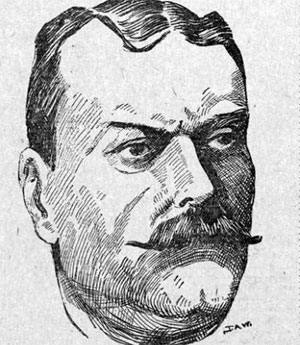
John McGurk (1859-1913) proprietor of McGurk's dive at 295 Bowery 1895 to 1900He was described in 1899: "A broad shouldered man with a fat face, two chins, puffy eyes, and short-cropped grey hair" - well dressed - he wore a big diamond on his shirt and another on his finger. He was known in the neighborhood as a "foxy guy" and he was "not without admirers".
"The secret of McGurk's success in promoting the suicide of girls and filling his pockets is, of course, the political backing he has in the Sixth Assembly district. He has a powerful friend in the Hon. Timothy Dry Dollar Sullivan, without whose assent no dive keeper could do business in Bowery for a minute." (Falls River Daily Evening News March 1899).MrGurk was said to possibly have been the boldest violator of the excise laws on the Bowery. There was no time of the day or night, weekdays or Sundays when a drink could not be had at McGurk's. McGurk's dives were frequented by thieves and loose women.

295 Bowery
1877: Schneckenburger Bros. restaurant, 295 Bowery - City Directory
1882: Bowery Hotel - 295 Bowery
Catherine Hottenroth - attempted suicide at 295 Bowery - predates McGurk by 13 years
(Report of the Commissioner of Health on Illuminating Gas)John McGurk 1889 to 1913
"Catherine Hottenroth, forty-four years old, 395 Bowery, August 22, 1882. Deceased left her home, 297 Bowery and engaged a room at the Bowery Hotel, (395) About 10 A. M. the next day August 20, she was found in an unconscious condition. Room full of gas, the key turned on full, and every crack stopped up with her clothes. She died at 295 Bowery, August 22. No doctor's testimony.The New York times covered the story on 21 August 1882 stating that a woman of respectable appearance who gave her name as Mrs. Hartman took a room at the Bowery Hotel, 395 Battery on Friday night and took an additional room on Saturday. Alerted by the smell of gas in the hall the room was entered. The woman was found unconscious in bed. She was taken to Bellevue Hospital. The police determined that her name was Catherine Hottenroth age 41, wife of C. C. Hottenroth, harness maker of 297 Bowery. Catherine Sandrocke Hottenroth had been born in Germany and she was the mother of five children - two boys who had died of diphtheria five years before and three girls who were still living. Morning the death of her sons she had attempted suicide four years previously by trying to drown in Central Park Lake and three years previously she had taken poison.Verdict: Suicide by illuminating gas while temporarily insane.
1866: Immigration June 25, 1866 Chr. Hottenroth age 27, saddler, to New York with Catherine age 28 and Emilie age 2 and a baby age 3 months from Bremen to New York on the New York
1867: In August 1867 Charles "Ottenrath" of 297 Bowery was accused of being in possession of stolen harness belonging to a harness-make from Hartford, Connecticut. Ottenrath claimed he had purchased it "in the regular course of business" for $55. When they searched Ottenroths establishment the police found "a bit or peculiar construction" which the Hardford harness maker claimed was his, but they did not find the harness in question.
1877: Willie born 1872 died October 5, 1877 and Edward Hottenroth born 1874 died 1 Oct 1877 buried Woodlawn Cemetery, Bronx, New York, United States (Ancestry.com)
1878: New York Times - 22 July
"Mrs. Katherine Hottenroth, wife of a saddler doing business at No. 298 Bowery, wandered away from her little daughter with whom she visited Central Park, on Friday. She was found on Saturday night haunting the shores of the lake, and was restored to her friends. It is believed that grief at the loss of two children has unhinged her mind and that she contemplated suicide."1880: Christian Hottenroth 42, saddler, Prussia, Catherine Hottenroth 43, Prussia, Emily Hottenroth 16, Prussia, Annie Hottenroth 14, New York Julia Hottenroth 13, New York, Adolph Hottenroth 11, New York Freddie Hottenroth 9/12, New York
1882: Death Catherine Hotteuroth 22 August 1882 Manhattan, age 44 married buried 24 Aug 1882, born Germany
1900: Bronx Christian C Hottenroth 61, widow, real estate, Adolph Hottenroth 31, son, lawyer, Mamie Hottenroth 23, daughter in law, Fredirick Hottenroth 20, son, law clerk
John McGurk ran a dive at 295 bowery from circa 1895 to 1901.
1889: John H McGurk 78 E. Houston, home 1? Second ave. liquors
1890: Trow's Directory, McGurk John H. 253 Bowery & 73 E. Houston Wines Liquors and Lager Beer
1892: John H McGurk, 73 E. Houston, home 263 Bowery, Liquors
1893: Annual Report By New York Society for the Prevention of Cruelty to Children:
"March 6. (Case No. 70,879.)Among the various resorts of the Bowery and adjoining streets, which may be classed as " dives" without the least hesitation, the "man about town" would refer to that at No. 255 Bowery as entitled to first place in its particular sphere. Here vice is to be seen unadulterated and unadorned. Gilded fixtures and brilliant display of electric devices play no part in the attractions of this unique combination of wickedness. It would be difficult to picture in language such scenes as are nightly witnessed at "McGurk's." In this case it seems to have been "the survival of the fittest" in divedom, for while many other resorts have been closed, this still continues to cater to the typical Bowery pleasure seeker. The female habitues of the place are generally those far advanced on the downward path; but the Society has always closely observed the visitors there, to the end that no young persons of either sex should be allowed to come within its contaminating influences.
Hence on the night of this date when a young girl, apparently under the age of sixteen years, was found among the crowd, and engaged in a dance with a drunken sailor, she was promptly taken into custody, and the proprietor, John H. McGurk, who was present, was arrested and charged with a violation of Section 290 of the Penal Code, which provides that any person being the owner or manager in whole or in part of any dancehouse, or any place where wines, spirituous or malt liquors, are sold or given away, who shall admit to or allow to remain in such dance-house any child under the age of sixteen years, is guilty of a misdemeanor.
This case was stubbornly contested by the defendant, and as persistently prosecuted by the Society. On May 5th, 1893, McGurk pleaded guilty in the Court of Special Sessions, and was fined $250. The misguided young girl, who had been in the custody of the Society up to this time, was committed to the House of the Good Shepherd.
1894: City Directory - McGurk, John H., Liquors, 253 Bowery.
1894: LEASEHOLD CONVEYANCES. Bowery, No 295. Assign, lease. John H McGurk to Geo W Allen, Jr. Real Estate Record and Builders' Guide, Volume 53
1894: The building at 295 Bowery was used as a furniture storage warehouse for a company that had been established in 1875.
1895: Documents of the Senate of the State of New York, Volume 13 By New York (State). Legislature. Senate - John McGurk was named as one of the most notorious "dive keepers" on the bowery - at "153 Bowery".
McGurk also had a ten year lease at 251 and 253 Bowery and ran a bar at 253.
1895: McGurk opens "dive" at 295 Bowery
1899: March 9 The World gave the following history of the 19 year notoriety of John McGurk:
1An article in the Fall River Globe, Fall River, Mass. of July 9, 1895 claims McGurk lived in Fall River as his "first place of residence in the USA, where he worked as a deck hand on local steamers. He then moved to Boston for a year or two circa 1880 where he was known as John H. Goff and ran a small ballroom.
- 1859 - birth in County Tyrone, Ireland.1
- 1879 - Conductor on a Third avenue car
- 1880 - Bouncer in Owney Geoghegan's Bowery dive
- 1886 - Head bouncer at Billy McGlory's Bowery dive
- 1889 - Proprietor of dive at 251 Bowery - Member of Tammany Hall General Committee
- 1890 - McGurk arrested by Acting Capt. Creedon - Young girls frequent dive.
- 1891 - Contributed $1,000 to fund to make Creedon a full-fledged Police captain
- 1891 - Opens dive at No 1 at First street an Bowery. Purchases four story brown-stone house at 212 E. 77th for $17,800
- 1892 - Raided - 300 arrested, convicted and fined $100; closes; reopens; "plunges into real estate"
- 1893 - Raided but is discharged; No. 251 Bowery closes; fixtures sold at public auction; changes politics and becomes a Republican
- 1895 - Opens dive no. 2 at 295 Bowery. Buys other real estate on Bowery near Houston. 2
- 1896-1897 - dives still flourishing. Republicans go out of power.
- 1898 - Becomes a Tammany man and contributes to Big Tim Sullivan's campaign. Opens dive no 3 on 3rd ave near 13th street.
- 1899 - March 2, Bess Levery kills herself by taking carbolic acid at McGurks's dive; March 5, Florence Levine takes poison at McGuck's and is sent to Bellevue; March 7, Emma Hartig a frequenter of McGurk's takes poison; March 9, Police say the have no complains against McGurk and do not have a reason to close him down, McGurk says his place serves a purpose to keep women off the streets, he was reputed to be worth over $200,000 which he made by selling 5 cents drinks for 15 to 15 cents.
(Note: There are discrepancies with other reports on McGurk's activities.)
1It was also reported that he opened 295 Bowery in 1892 and that he leased the property at 295 Bowery in 1895.
1899: - March 9 - McGurk's was said to have a pianist, a violinist and a cornet player as well as an exceedingly well waxed floor for dancing.
1899: - Mar 10 - Patrick McGurk, brother of John McGurk, manager and part owner of the dive at No 295 Bowery was arrested on a warrant issued by Magistrate Pool of the Yorkville Court. McGurk had a hotel licence.
1899: March 11, Patrick McGurk was arrested at 295 Bowery, but the establishment was not closed. Two other "resorts" only three doors away and also run by the McGurks were not bothered. No "great importance" was given to the action by the police "it being regarded merely as a move to tide over public clamor against McGurk's places".
1899: - In March 1899 several papers reported that a feature of "McGurk's concert hall" was a large fresco depicting McGurk extending a hand to Admiral Dewey as Dewey disembarked from his flagship on his return to the United States. (Dewey returned from the Philippines on September 27, 1899.??)
1899: March 11 - McGurk's dive at 295 Bowery was closed tight at one o'clock in the morning for the first time since it opened. A few hours earlier Patrick McGurk, the manager and the brother of the owner, had been arrested and charged with running a disorderly house. He was called to the bar of the Yorkville Court where his lawyer secured an adjournment claiming that he could produce evidence that the place was eminently respectable. He was released on $500 bail. John McGurk was absent due to illness.
1899: April 2 The holder of the liquor tax certificate of John McGurk's saloon at 295 Bowery received a summons to court to show cause why the licence should not be revoked. The charges was that the place was open after hours. The certificate for McGurk's was made out to John Hunker and dated May 1898. It was due to expire May 1899. John McGurk had been ill for several weeks and claimed he had nothing more to do with 295 Bowery.
1900: 209 E 18th street, John H Mcgurk 46, speculator, imm 1870, Louise Mcgurk 32, 1 child 1 living, married 15 years, imm 1875, Agnes M Mcgurk 15 Delia R Flanagan 20, servant
1900: March 13 - McGurk's dive was raided by the police but a tip-off had warned of the raid and all the women had been told to leave by the manager long before the raid occurred. McGurk himself was warned of the raid and had gone to Florida.
1901: Documents of the Assembly of the State of New York, Volume 28 By New York (State). Legislature. Assembly Valuations of buildings: 291 and 293 Bowery and including Volk's Garden $85,000 no increase in value - 295 Bowery McGurk's $25,000 no increase in value.
1901: Annual Report of the State Superintendent of Elections - "McGurk's Suicide Hall, and other nefarious resorts" "McGurk's, otherwise known as "Suicide Hall" on the Bowery."
1901: June - the liquor tax certificate issued to Timothy Crowley of 295 Bowery, aka McGurk's Suicide Hall, was revoked.
1901: McGurk's at 295 Bowery was sold to George Schneider who said he would convert the place into a German family resort.
1905 Census: 209 18th street, John H Mcgurk 49, Ireland, real estate, Louise Mcgurk 32, Ireland, Martine Mcgurk 19, US, Katie Cackey 17, Servant
1909 - 1911: Lippman L Silberstein (Bernhard Lippman L Gerson Silberstein) 295 Bowery
1910: Riverside Ward 2, Riverside, California Almond street, John H Mcgurk 56, own income, Louisa A Mcgurk 42, 1 child 1 living, Martina Mcgurk 24
1911: The National Provisioner - Grocers Delicatessens, Hotel and Restaurant Fixtures - Manhattan Mortgages - 295 Bowery - Weinstein, Morris : Frank Read $1,575
1912: John H McGurk Home, 1060 Almond Riverside, California, USA Publication Title: Riverside, California, City Directory, 1912
1913: John H McGurk, Birth, 1855 Death 29 Jan 1913 Death Place: Los Angeles, California, USA
The papers reported that he died in Pasadena, Cal. He had gone to California circa 1907 in search of a TB cure. McGurk, his wife and daughter were all said to have TB. His death was variously given as throat cancer, paralysis due to a stroke, or tuberculosis.
1913: March 16, 1913, Residence at time of will East 18th street, Manhattan, pay lawful debts, left his estate (both real and personal) to his executors, to collect rents profits and income to benefit his beloved wife, Louise Agnes McGurk, during her life, and to benefit his daughter Agnes Martina upon the death or remarriage of his wife.
1913 Death: Louise C McGurk, Birth Year: abt 1866, Death Date: 14 Dec 1913, Age at Death: 47, Death Place: Los Angeles, California, USA
Patrick McGurk
John's brother, Patrick, appears to have taken more control over the establishment as John became sicker. According to an article about Pat's arrest in 1899 he claimed to be 49 years old and live at 295 Bowery.
1899: 10 March - Patrick McGurk was arrested for maintaining a disorderly house. While John was believed to be the owner of McGurk's Patrick had an interest in it. John was sick with cancer (or TB) in March 1899. No sooner that Pat was arrested but he was back to work at the cashier's desk. March 21 - Patrick failed to appear in court claiming he was ill. A bond of $500 was forfeited.
295 Bowery 1916 to 1933
1916: Valentine's Manual of Old New York
"A little way above Grand Street on the same side stood, after the elevated road was built, "suicide post," the nearest railroad pillar to McGurk's dive, whence came men and women derelicts to lean against the post while they shot themselves or swallowed poison."1919: Store Fixtures - Kabram & son, M. 295 Bowery (1917 Store Fixtures - Kabram & Son M. 289 Bowery)
1921: The American Contractor, Volume 42 - new extensions to 5 story 23x94 295 Bowery
1933: "McGurk's famous dance-hall at Third Street and the Bowery rated a suicide a day." The Real Guide New York
The Grisly History of the Bowery's Infamous "Suicide Hall"
The Sinister Story of McGurk's Suicide Hall: The Bowery's Most Notorious Dive
Suicides or attempted suicides at McGurks
Carbolic acid was a common household item. A small bottle cost ten cents. The antidote was alcohol. It was thought that the large number of attempted suicides by carbolic acid was due to the publicity the suicide method received in the press.
- May 3, 1899 - ✟ Charles A. Mines, of Montclair, NJ shot himself
- March 1, 1899 - ✟ "Sailor Bess" Lovery, aka Bessie Duffy aka Sailor Duffy aka "Tattooed Bess", age 20, carbolic acid at Bowery and First, died
- March 7, 1899 - Emma Hartig (Hartwick), aka "Little Em", age 16, attempted suicide by swallowing Paris Green at McGurk's (or at First street and the Bowery, "close by McGurk's"), taken to hospital and had her stomach pumped.
Reported to be the daughter of Rudolph Hartig, an usher in the Irving Place theater. The Boston Globe reported that she died. However, she testified about her life in a disorderly house at a hearing in June 1899.
- March 8, 1899 - Florence Levine, 20 (19), of Troy, New York, attempted suicide by drinking carbolic acid at Bowery and First reputed friend of Bessie Duffy, lived at 17 Second Street
- March 12 1899 - Sophie Levinges (Levings), age 23, handsone frequenter of McGurk's, turned on the gas in her room, found unconscious, taken to hospital, from Stuttgart, Germany
- March 14, 1899 - Pauline Morilla, age 18 (her father said she was 15), attempted suicide, carbolic acid
Pauline was from Brooklyn. Her father testified that she was wayward and visited several dives including McGurk's. She was arrested in a raid at Docktor's Raines law hotel. On 15 March 1899 she was given in care to the Children's Society.
- March 14, 1899 - Flora Harven, age 18, attempted suicide, carbolic acid
- May 12 - Alice Keefe, age 15, attempted suicide with gas
She ran away from her home at 94 Forth street, South Brooklyn in February. She claimed she was seduced and kept against her will by Julius Docktor and his wife who kept a Raines law hotel at 594 Bowery. She was found on March 9 and sentenced to be committed to a reform institution. The news reported that she had frequented McGurk's.
- May 12, 1899 - Tena Anderson age 19, attempt carbolic acid
May 3, 1899 - "Lena" Anderson, a Swedish servant girl, attempted suicide by drinking carbolic acid in front of 263 Bowery, "within a block of McGurk's Suicide Hall". She was saved by a policeman, who jumped forward and knocked the contents of the bottle from her hand. She had attempted suicide eight months earlier in Central Park, despondent over the fact that her sweetheart had gone to war.
- Aug 14 - ✟ Tina Gordon aka Tina Kock, age 27, died (listed as carbolic acid in some papers)
She was born in Canada of a French mother, was a singer at McGurks Merrimac Hall on Third ave. near 14th street. When her voice faded McGurk made her a cashier. She drifted - went to Coney Island - Florida. She lost her looks. She was ill after an opperation. She went to Bellevue and then to City Hospital on Blackwell's island where she died. McGurk viewed her body at the morgue where he prayed and cried for her and forgiveness for himself and arranged for her to be buried in Calvary cemetery. It was reported that McGurk lamented that the press had persecuted him and the things they had printed about him caused the nuns to turn his 17 year old daughter from the convent school she attended.
- September 11, 1899 - ✟Bella Anderson, aka Belle Magee, about 30 years old, weighed more than 200 pounds, frequenter of McGurk's, committed suicide by drinking carbolic acid near 4th avenue and 8th street.
Bella Anderson, Age: 27, Birth Year: abt 1872, Death Date: 10 Sep 1899, Death Place: Manhattan, New York, USA, Certificate Number: 26244
- October 11, 1899 - ✟ Madge Davenport aka Lillian Page, 21ish, carbolic acid, from Boston, daughter of a clergyman or maybe a prominent politician, died at Bellevue, and her friend Mamie White
Madge Davenport, Age: 21, Birth Year: abt 1878, Death Date: 10 Oct 1899, Death Place: Manhattan, New York, USA, Certificate Number: 28605
- October 11, 1899 - Mamie White, 21ish, carbolic acid, from Boston, taken to a prison ward (It was said that Madge and Mamie made a pact to die together and that after they took the acid they were thrown out on the street so they would not die in the saloon.)
- March 29, 1900 - ✟ Emma Sexton, carbolic acid, in her apartment with the doors locked, after a fight with her boyfriend, a frequenter of McGurk's, good looking, hard drinker
Emma Sexton, Age: 23, Birth Year: abt 1877, Death Date: 28 Mar 1900, Death Place: Manhattan, New York, USA, Certificate Number: 10651
John McGurk did not own the property at 295 Bowery.
In November 2020 Steve Bornemann sent a clipping of a New York Tribune article from 15 March 1900 stating that Henry J. Schile was the "reputed owner of McGurk's place at No. 295 Bowery". The "place" was described as a "disorderly resort" and abatement was requested. Mr. Schile's lawyer, Lewis S. Goebel, averred that Henry J Schile was not the owner - the property belonged to his son, Romeo H. Schiel. Romeo was ready to "proceed against the tenants" if it could be legally shown that the place was "being conducted in an illegal manner." Proof was put forth by the DA who asked that abatement steps be taken immediately. The assistant DA testified that three women solicited and "smoked cigaretts in the place". He also testified that a murder and robberies were planned there and subsequently carried out there. The manager of McGurk's was George Furman who was charged with keeping a disorderly resort and held in $500 bail. Furman was also charged with violating the Concert Hall act.295 Bowery - George Furman1920: Sept - Adams & Co sold a five story building at 295 Bowery, 23.4 x 94.6 for Carrie Schile to the Brooklyn Jobbing House who planned on instaling elevators and using the upper stories for their business. (Carrie was the first wife of Romeo Schile.)
1860: New York Ward 7 District 2, Henry Schele 28, gilder, Baden, Margaret Schele 20, Hepe Capel, John Schele 3, Romeo Schele 1, Philip Schele 1/12, Philip Ems 22 gilder Hepe Capel
1870: New York Ward 10, Division street, Manhattan, Schile, Henry age 40, frame store, Margarethe age 30, both born Prussia Julia 13, Romeo 12, Irvin 10, Amanda 9, Freada 6, John 3 Henry 1 all born New York, Thomas 30, William 20, Henry 21 all born Prussia
1892 City Directory:
1898 Passport: Romeo H. Schile, age 35, dob 23 Sept 1858, Brooklyn,
- Schile, Erwin B. Furniture, 295 Bowery, home 652 W. 152nd st
- Schile, H'y J . Furniture, 295 Bowery, home 652 W. 152nd st
- Schile, John, Furniture, 295 Bowery, home 652 W. 152nd st
- Schile, Romeo, Furniture, 295 Bowery, home 652 W. 152nd st
- H & sons Furniture, 295 Bowery
1900: March 15, 1900 Goebel (Romeo Schile's lawyer) declares in writing that Romeo Schile is the owner of 295 Bowery. (Steve Bornemann, December 2020)
1900: Manhattan, 146th street, Schile, Romeo, 42, married 4 years, real estate, Carrie, wife, age 36, 2 children 0 living
1908: November 8, 1908, the NY Times reports a Mechanics Lien - Bowery, 295. Glassman Bros. against Carrie Schile. owner; Joseph Polansky and Ida Cohen, contractors, $200 (Steve Bornemann, December 2020)
1910: Richmond, Romeo G Schile 52 Head, own income Carrie, 46 Wife, no children
1920: Richmond Assembly District 1, Richmond, New York 95 Louis St Romeo H Schile 61 Head, real estate own account, Carrie Schile 56 Wife
1928: 10 May 1928 death of Carrie Schile Birth Date: 2 Jun 1863, Death Date: 10 May 1928, Death Place: Saint George, Richmond County (Staten Island), New York, Cemetery: Woodlawn Cemetery, Burial or Cremation Place: Bronx, Bronx County, New York, Spouse: Romeo H. Schile, https://www.findagrave.com
Carrie "Schill", [Carrie Mayers], Marital status: Married, Age: 64, Birth Date: 2 Jun 1863, Birth Place: New York City, Death Date: 10 May 1928, Death Street Address: 95 Louis St Tompkins Ville, Death Place: New York City, Richmond, New York, Cause of Death: Myocarditis; Angina Pecloris, Burial Date: 13 May 1928, Burial Place: Woodlawn New York, Occupation: House Wife, Father's Birth Place: Germany, Mother's Birth Place: Germany, Father: Henry Mayers, Mother: Mary Mayers, Executor: Mr Romeo W Schill, Executor Relationship: Husband, Certificate Number: 910
1935 Marriage: Romeo Schile, Marriage Date: 1935, Marriage Place: New Jersey, USA Spouse: Elsie Seitz
1939: Death, Romeo H Schile, Age: 80, Death Date: 30 Apr 1939, Death Place: Richmond, New York, USA, Certificate Number: 842
Romeo H "Schife", Marital status: Married, Age: 80, Birth Date: 23 Sep 1858, Birth Place: Brooklyn, New York, Residence Street Address: 95 Louis St, Residence Place: New York, Death Date: 30 Apr 1939, Death Street Address: 95 Louis St, Death Place: New York City, Richmond, New York, USA, Cause of Death: Myocarditis Auricular Flutter Arterio Sclerotic Heart Disease, Burial Date: 4 May 1939, Burial Place: Woodlawn Cemetery, New York, Occupation: Lithographer, Father's Birth Place: Germany, Mother's Birth Place: Germany, Father: Henry Schife, Mother: Margaret Schife, Spouse: Elsie Schife, Informant Gender: Female, Informant Relationship: Wife, Executor: Elsie Schife, Executor Relationship: Wife, Certificate Number: 842
Romeo H. Schile, Birth Date: 23 Sep 1858, Birth Place: Brooklyn, Kings County (Brooklyn), New York, Death Date: 30 Apr 1939, Death Place: Saint George, Richmond County (Staten Island), Cemetery: Woodlawn Cemetery, Burial or Cremation Place: Bronx, Bronx County, New York, Spouse: Carrie Schile, https://www.findagrave.com
George Furman, age 36, address 1928 3rd ave., was the manager of McGurk's on March 13, 1900 when a raid on the place was rumored. Furman and the head bouncer "Batty" O'Connor ushered all the ladies out and only allowed gentlemen in the place. Bowery folk gather round to witnesses the raid. Much to their disappointment only one police detective showed up, talked to Furman and quietly left with him.295 Bowery - Charles Moon - Bouncer McGurk'sFurman was brought to court where, on March 19, he was charged with a violation of the Music Hall act. He was accused of having music in a drinking place and was held on $500 bail. The place did no have a concert license. Furman's lawyer claimed that whatever music was being played was in rooms where meals were served. He intended "to test the question of whether it was a crime to have music in restaurants in the Bowery and legal to have it in big hotels in Fifth-ave." He suggest checking out the Holland House and the Waldorf-Astoria. The magistrate thought it was a good idea.
Furman was questioned as to the identity of the landlord. The name reported in the papers was "Sheil" (should have been Schile). It was testified that "Sheil" owned the place. That he leased it to McGurk who subleased it to Robert Bridges.
1900: Census 1928 3rd ave. George Firman 36, born NY, mgr lig, saloon, Ida Firman 27, wife, Beatrice Firman 5, daughter, Georgie Dickerman 42, sister in law, Horace Dickerman 36, bro in law, stone cutter (?)
1899: - December 3 Charles Moon, a barker at McGurk's and a reported Tammany man, was involved with violating the election laws. He was said to be one of the men who arranged for "colonization". He found men to go into a district and register to vote thereby packing certain key districts. When Mr. Moon was arrested he was in possession of a list of names of men who were known panhandlers and crooks. The court believe that many men on the list were registered illegally. Voter fraud was widespread in New York at the time. Political bosses made up voters lists that include many phony names. Members of the politcal machines were encouraged to "vote early and vote often".295 Bowery - William Strauss - bartender McGurk's1900: May 23 - Charles Moon, age 30, a bouncer at McGurk's dive at 295 Bowery, was arrested by the State Superintendent of Elections and charged with conspiracy to violate the state's election laws. He was indicted for inducing fraudulent registrations in the 10th assembly district. He was sentenced to two years and five months in prison.
Charles Moon was sentenced on May 22 1900 "2-5 C-- Vio Election Laws" and sent to Sing Sing prison in Ossining, New York. The Sing Sing Prison record includes the following information: Born New York, age 30, occupation, reporter & stenographer, brown eyes, dark brown hair, 5'7" 163 pounds, can read and write, smokes, single address where arrested, 295 Bower(McGurk's place)
He was listed in the 1900 federal census at the prison at Sing Sing: Birth Aug 1870, parents born Ireland, stenographer
In April 1900 William Strauss, a bartender at McGurk's, was sentenced to Sing Sing for 10 years and six months on a charge of robbery. Philip McKenzie, a nephew of McGerk's was sent to Elmira Reformatory. The two men were reported to have robbed a man who had drank to excess. They followed the man as he left McGurk's and attacked him at the corner of Bleeker street and the Bowery.293 Bowery - Plinus and Lerhman Store and Office fixtures in 1915Max Strauss, alias William Lobenstein, alias William Schwartz, alias, William Smith, alias, Max Muler, was sent to Sing Sing on July 18, 1902, Charged with burglary in the 2nd degree, sentence 7 years, Age 32 born Germany, occupation, tailor, religion Hebrew, married, smoker, brown eyes, black hair, 5'8", 130 pounds
1919: Lehrman V, 293 Bowery store fixtures1921: Lehrman Bros. (Usher and Jacob) 193 Bowery Trow directory

1893 map showing Germania rooms at 291- 293 Bowery - NY Public Library
Harmony Gardens (Harmonia Hall) - 139-145 Essex street
Harmonia Hall AKA Harmony Garden had several owners over the years. In 1870 it belonged to the partnership of Henry Goering and George Eckels. By 1885 it was owned by Christian Supps.
1859: 145 Essex street was listed as a slaughterhouse belonging to Mr. Henry Hyde when a fire broke out in January of that year.
1859: At the 9th annual festival of the New York Turnvereins on Whit Monday in June of 1859 Germans turned out to march to Elm Park. Different groups gathered at different places to begin the march. The numerous Glee Clubs started from Harmony Gardens on Essex street at 8 o'clock in the morning. They marched though Grand Street, Bowery, up Broadway and down Canal to Spring street where boats awaited them. At least 6,000 people gathered to celebrate in Elm Park.
1860: April - There was a meeting in a large hall at Harmony Gardens on Essex street of about 400 German cabinetmakers and piano makers in an effort to keep prices up and express solidarity with striking shoemakers in Lynn.
1860: October - The New York Turnverein gave a performance of singing, dancing and gymnastics to benefit the German Free School.
1861: Civil War recruits from the United States Vanguard were quartered at Harmony Gardens.
1861: Harmonia "Garten" held a Thanksgiving ball.
1862: June 25, Meeting of honorably discharged Union soldiers to petition the government for the payment of a $100 bounty promised at enlistment was held at Harmony Garndes on esses street.
1863: Christmas night there was a ball at Harmony Gardens on Essex street.
1868: The Kunitz Light Guard gave a Thanksgiving Day ball in Harmony Graden in Essex street.
1870: The partnership of the proprietors of the Harmony Ballrooms and Restaurant at 139, 141, 143 and 145 Essex street was disolved by mutual consent. Henry Goering was responsible for all debts. George Eckels and Henry Goering.
1870: George Eckels and Henry Goering were both listed at 143 Essex street in the 1870 census. "Gering", Henry age -0 [30?], ret lig dealer, Anna M age 20, and Eckels, George age 30 ret lig dealer, Charles 10 and Lilly age 7
In 1865 George Eckels had an eating house and a ret lig dealership at 13 Rivington in partnership with Peter Watteru[?]
1872: Henry Goering 145 Essex Occupation: Beer Publication Title: New York, New York, City Directory, 1872
1872: About 150 German bakers met at Harmonia Hall at 145 Essex street to organize a strike for a 10 hour workday and a 50 cent increase in wages. They had been working 12 to 16 hours a day.
1872: June, wheelwrights and blacksmiths met at Harmonia Hall 145 Essex street to call for a general strike. The previous day wood turners, saw miller, engineers planers, and moulding makers had met at 145 Essex street for a similar purpose.
1873: Henry Goering, 143 145 Essex, Publication Title: Goulding´s Business Directory of New York, 1873-74
1873: In July 1873 Harmony Gardens maintained a low profile on Sunday evenings. The front door was closed and the shade were pulled down. There was a fair crowd of customers but they kept the laughter and other noise down.
1874: In 1874 George Eckels was a member of a committee of German saloon-keepers who met with the police commissioner in reference to the recent order for suppression of the Sunday theaters. At that time he was listed "of the Beethoven Maennerchor Hall" 1874: A Masquerade ball was given at Harmony Gardens in Essex street in January 1874. Permission was given by the police in spite of the Sunday laws.
1876/1877: Henry Goering, 145 Essex Occupation: Beer Publication Title: Goulding´s New York City Directory for 1876-77
1880: Henry Goering 143 Essex Occupation: Beer Publication Title: New York, New York, City Directory, 1880
1880: List of registered voters in the 8th assembly district Lawrence Lang and Christian Supp at 145 Essex street.
1883: L. Lang was the proprietor and Christian Supp the manager of Harmony Rooms 139 and 146 Esses street when they opened Ocean House in Rockaway Beach - a hotel and iron pier with the best accommodations for picnics and parties.
1885: January 30, The Sangerlust Society had a ball at Supps' Harmony Rooms a 139-145 Essex street. Price Carnival was inaugurated. There was drinking, dancing and singing and pretty blond German girls in costumes.
1885: November Christian Supp proprietor of a beer shop on the first floor at 145 Essex street under the Harmony Rooms applied for a renewal of his excise licence. His lawyer produced a diagram of the property showing that Supp's place was not connected to the Harmony Rooms and stated that no performances were given in the rooms. The Judge wanted to inspect the property before granting the licence. An argument was made that the Judge had granted a licence to the Metropolitan Hotel without inspecting it. Weren't the rights of a poor man equal to a rich hotel keeper? Action was delayed.
1885: November Christian Supp obtained a excise license for the bar at Harmony Hall nos. 141 to 145 Essex street by agreeing to put a false door over a vestibule door leading from the hallway to the assembly rooms.
1883: November 13, Christian Supp was the proprietor of the lager beer saloon at 145 Essex street known as Harmony Hall. Mr Supps' request for a liquor licence renewal was turned down. It was stated that the saloon was on the ground floor of no 145 and was separate from the hall on the second floors of 139, 141, and 143 Essex street - that the hall was used for meeting and not for "theatrical exhibitions" and there was no connection between the two establishments. The commissioners visited the locality and found a door between the saloon and the hallway that led to the meeting rooms. It was agreed that if the door was permanently closed a license could be issued. 1888: Annual reception of the Peter Braun Association at Harmonia Rooms 139-145 Essex street December 16
145 Essex street is between Rivington and Stanton.
NYPL digital collection c 1868Harmonia Hall was at Nos. 139, 141 and 143 Essex street.
Henry Goering
1870: 143 Essex Street, Gering", Henry age -0 [30?], ret lig dealer, Anna M age 20
1873: Naturalized April 1873, Henry Goering, saloon keeper, 139 Essex, common pleas court
1873: Passport application. Born Bavaria August 15, 1843 5 feet 6 inches, dark brown eyes dark brown hair., naturalized April 1873, common pleas court
1880: Goering H age 38, Marie wife, age 41, 173 Essex Street, saloon, born Bavaria
Christian Supp
1878: Christian Supp, Street address: 178 Essex, Occupation: Waiter, Publication Title: New York, New York, City Directory, 1878
1880: 145 Essex Street, Christ Supp 39, proprietor of the Harmony Restaurant and Brewery, born Wurtenburg, Josephine Supp 30, born New York, Annie Burkart 42, sister in law
1883: Christian Supp, 143 Essex, Occupation: Beer, Publication Title: New York, New York, City Directory, 1883
1892: Christian Supp Birth Date: 30 Oct 1841 Death Date: 22 Aug 1892 Cemetery: Old Saint Raymonds Cemetery Burial or Cremation Place: Bronx, Bronx County, New York, USA (Find a Grave)
Josephine born March 25, 1849 died Feb 5 1895
1893: Probate for Christian Supp, October 20, Ward 23, left everything to his wife, Josephine.
1895: Probate of Josephine Supp - widow of Christian Supp - to the Church of the Immaculate Conception of 151st street, New York $1,000 for masses for the repose of the soul of Christian Supp and herself - $100 to father John Deuges of the Immaculate conception - to her sister Eliza Lutz widow $50 - to Caroline Supp wife of Henry Supp $50 - to her nephew Henry Burckhardt son of Baltasar and Eva $200 - to her nephew and niece William Burchardt and Louisa Meyer children of Baltazar and Eva in trust $500 - - the remainder of the estate to to William and Louisa
Hillenbrands (Metropolitan Rooms) 156-170 Hester street
1850: In April The Confectioners Benefit Society held its first meeting at Hillenbrand's Hall on Hester street. The group was princely made up of German bakers.
The German locksmiths also held a preliminary meeting at Hillenbrand's in April.
another meeting held at Hillenbrand's was composed of iron and metal workers including blacksmiths, tin smiths, locksmiths, coppersmiths, and others.
1851: 11th Ward polling place Hillenbrand's 170 Hester.
1853:
Sugar bakers met at Hillenbrand's Hall, 160 Hester street in April 1853. The were seeking an increase in wages from as little as 87 cents and a much as a dollar a day to a larger wage of $1.25 for a 10 hour day for all sugar bakers. A sugar baker or sugar refiner worked in a sugar refinery and processed the raw sugar into white granular sugar. Sugar bakers suffered for a form of eczema called sugar baker's itch.
1855: Mechanic's Hall - 160 Hester Street.
1856: June 24 - About 40 Frenchmen met to commemorate the Parish insurrection of June 1848 and the Bread Riots. "French songs sung - German lager bier drank - and American cigars smoked." A good time was had and the party lasted until late.
1859: January 14 - A gathering of the "Red Republicans of all nations" met at the Metropolitan Rooms on Hester street to celebrated Orsini's assault on Louis Napoleon. Speakers addressed the gathering in five languages. Orsini
1859: In 1859 the Schillerbund society celebrated the one-hundredth birthday of the German poet, Fredrich Schiller, with a concert on Nov 10 in the Metropolitan Rooms in Hester Street.
1860: Feb 17 - Master bakers met at 160 Hester met to devise some "mode of protecting their interests against the enterpriser of Mr. Hecker, who by the aid of large capital and machinery sells larger loaves of bread that it is possible for them to do at the same price."
1860: February 24 Liquor Dealers Association met at the Metropolitan Rooms Hester Street.
1860: March 6, Liquor Dealers Society met at 160 Hester street.
1862: The Teutonia Maennerchor a singing group met at Hillerbrandt's Metropolitan Rooms for their annual festival. About 600 people attended and were entertained by vocal and instrumental music and a ball in the "elegantly decorated saloons".
1862: March - The Germania Sing Verein held a ball at the Metropolitan Rooms on Hester Street where "masking and mumming*" were the "order of the day". It was one of the most "good-humored, jollity" of the season. Almost the entire crowd was in masquerade. The refreshment rooms and the dancing hall were brilliantly lit. The dancing hall was lighted with several massive chandeliers, with illuminated globes "yielding more tone and color than bare, staring gaslights could." The rooms were festively decorated with both American and German colors. An excellent band played, waltzes, polkas and reels. Around midnight a burlesque was given.
*Mummers were originally bands of masked persons who during winter festivals in Europe paraded the streets and entered houses to dance or play dice in silence. (britannica.com)
1864: The Musical Mutual Protection Union met at the Metropolitan Rooms 156- 160 Hester street. Musical Mutual Protection Union
1869: Company B of the 5th Regiment national Guard held target practice and summer's nights festivals. The convened at the 5th Regiment armory on Hester street, marched for several blocks, then took cars to Hamilton Park.
1869: June - Auction foreclosure - 158 160 Hester street - entire furnishings, fixtures, in the lunch, billiard, meeting and lodging house - bar, counter, shelving, mirrors, "splendid" billard tables, balls and cues, chairs, benches, round and square tables, glassware, crockery, clocks, engravings, knives and forks, desks, icebox, two large kitchen ranges, copper boilers, Brussels carpets, etc.
1869: September - Irish Fenians met at the Metropolitan Rooms on Hester street.
1870: Milk dealers association met at 160 Hester street in August.
1871 and 1872: The 5th Regiment National Guard met over Hillenbrand's lager beer saloon at 156-160 Hester Street. Rent was $2,500 per quarter.
1871: Meeting of the Irish exiles of the 14th ward was held in august.Z
1872: 5th Regiment at 156, 158, and 160 Hester street in fair condition with a leaky roof.
1872: The Societa D'Italiani Cittadini de Nuova York met at the Metropolitan Rooms on Hester street in September.
1872 - 1877: John Lammer was listed at 160 Hester, (beer, liquor, and no occupation)
1880: The milk dealers union met at 160 Hester to establish prices for milk for the winter. Retail prices were 6 8 and 10 cents a quart. The lower price milk containing a larger percent of water to milk.
1881: McGlory's Armory Hall 156, 158 and 160 Hester street near the Bowery throughly overhauled - one of the best dancing and variety halls in the city - best dancing, best music. Admission free. Jewish Ball every Sunday evening.
1887: Armory Hall Vaudeville Theatre 158 to 160 Hester Street All Star Novelty Company Every Night.
1887: December Armory Hall Vaudville Theatre the finest company in America. Hughes, and Clark, Frankie De Forrest and Southern Serenaders under management of Billy Speed.
1888: June - "Billy McGlory's notorious dive, Armory Hall at 258 and 160 Hester street" was closed by the Board of Health and condemned as unfit for human habitation. Sanitary inspectors had been through the building several times in the preceding months and had ordered that it be repaired, cleaned and disinfected. The Armory had formerly been the home of the 5th Regiment until they were mustered out in 1880.
"Billy McGlory secured it and under his proprietorship it obtained a reputation as a dive where the wildest and most immoral orgies were committed. Billy was sent to prison from it, but opened again on his release." (The Evening World June 8, 1888)Billy McGlory was a saloon keeper and underworld figure. See Billy McGlory
1889: Thomas C Smith sold 156, 158 and 160 Hester street, with the four-story brick building thereon known as " Armory Hall".... He sold other properties at the same time. Real Estate Guide - NY times - four story brick building and two three story brick buildings with a plot of land, 134.3 by 99.2 by 133.11 by 100 - 156 to 160 Hester street southwest corner by 108 to 110 Mott.
1900: Valuable Property for Auction March 27, 1900, 156, 158 and 160 Hester - 7 story and basement - brick, stone and iron building with large plot of land - also 108 and 180 1/2 Mott street.
Joseph Hillenbrand[t]
1834: March 1 birth
1861: New York National Guards
1862: Joseph Hillenbrandt was the Captain of Company E 5th (Light Infantry) Militia, Jefferson Guard
- 2nd Lt Reg't 3 birg 2 1857
- 1st Lt Reg't 3 Brig. 1 1859
- Capt. Reg't 5, Brig 2 1861
1862: Tax, Hillibrand, Joseph H 160 Hester street, retail liquor $20.
1863: Draft Registration - 160 Hester Street Hillenbrand, Joseph age 29 -en-tor, married born New York, belongs to 5th N. Y. S. M
1864: Tax - Hillenbrand, Joseph listed twice, 160 Hester street, retail liquor income ex $600, value 2030, amount of tax @0 and $60.
1865: Joseph Hellenbrandt was the Festival Marshal for the German Saengerfest at Jones' Woods July 19, 1865
1870: Joseph Hillenbrandt was a member of the Beethoven Maennerchor of the City of New York.
1870: Ward 12 no address, Joseph Hillebrand 36, reti merchant, $15,000 $15,000, Elizabeth Hillebrand 33, Joseph Hillebrand 8, Caroline Hillebrand 5, Henry E Hillebrand 3, Annie Yellinger 37, servant, Catherine Koch 21, servant
1873: Joseph Hillenbrandt was paid $2,500 in rent money for the quarter ending August 1, 1873 AND the quarter ending November 1, 1873 for the armory at 156 to 160 Hester street.
1880: 433 E 86th street, Joseph Hillebrand 44, retired merchant, Eliza Hillebrand 43, wife, Joseph Hillebrand 19, clerk store, Caroline Hillebrand 15 Henry Hillebrand 13 Christian Hillebrand 10 Catharine Hillebrand 5 Francis Hillebrand 1, son and three servants
1884: April 20, Joseph Hillenbrand, 433 E. 86th streed paid $25 to the New York, Hebrew Sheltering Guardian Society Records
1887: Death April 4, 1897 buried Evergreen Cemetery
Probate: Will written in New York probated in Monmouth New Jersey - pay just debts left everything else to his wife, Elizabeth.
Kmuschka's Concert Hall - Ave A
Kmuschka's Concert Hall was mentioned in the 1860 temperance movement New York Sabbath Committee's list of venues holding concerts on Sunday. It was called "Concert Hall in 1859 to 1863 and Constitution Hall in 1864.
Carl Kmuschka was born in Nassau Germany circa 1819. He was naturalized in 1861. Carl's first wife Henrietta Kmuschka died in 1875. Carl Kmuschka married Whilhelmina Rohde in 1876. Carl Kmuscka and Whilhemina Rohde had a daughter Anna born in 1879.
1857: Charles Kmuschka 85 Av A Publication Title: New York, New York, City Directory, 1857
1859: Carl Kmuschka renounced the Duke of Nassau 24 August naturalization petition common pleas.
1860: Kmuschka, Charles, beer, h 512 4th street, Trow's New York City Directory
1860: 18th Ward Working Mens Association rally to the Party - Land Reformers meeting at Concert Hall 229 Avenue A between 15th and 16th streets June 13th.
1861: Naturalization, Nov 21, Carl Kmuschka - Common Pleas, 229 Av. A, NYC no occupation, renounced the Duke of Nassau
1864: Call Constitution Hall 229 Avenue A
1870: Kmaschka, Charles age 51, musician born Hamberg, Henrietta age 50 born Wurtenberg
1875: Death of Henrietta Kmuschuka August 4, 1875
1876: Kmuschka Charles, musician, h 123 [133?] Rivington NYC Directory
1876: Marriage, Carl Kmuschka 6 Aug 1876 Manhattan, Spouse: Wilhelmina Rohde Certificate Number: 3802
1879: Child Anna born 12 March 1879 father Charles married Hirschhorn
Anna Kmuschka Hirschhorn, [Anna Kmuschka Kmuschka] , SSN: 507605168, Birth Date: 12 Mar 1879, Birth Place: New York City, New York, Father Name: Carl Kmuschka, Mother Name: Mina Rohde, Type of Claim: Original SSN., Notes: Apr 1963: Name listed as ANNA KMUSCHKA HIRSCHHORN1880: Charles Kmuschka, 146 Ludlow, New York, Occupation: Teacher, Publication Title: New York, New York, City Directory, 18801882: Charles Kmuschka 643 E 9th New York, New York, USA Occupation: Musician Publication Title: New York, New York, City Directory, 1882
Did not find a map with an obvious concert hall at 229 Avenue A near 16th street.
Lindenmuller - 49 Bowery
See map of the Bowery between Bayard and Canal below.1854: In January Mr. Lindenmuller, a German restaurant owner, was giving free dinners to poor Germans everyday between the hours of one and two o'clock. Tickets were issued GOOD FOR ONE DINNER at Lindemuller's Saloon 118 Chatham Street, New York.
1855: New Years Eve Ball at Lindenmullers
1855: A German gentleman named Lindenmuller, established a soup kitchen to fight the "fierce and hungry mouths" of unemployed laborers in New York.
1857: An article in the Brooklyn Daily Eagle reporting on the Dead Rabbits gang riots (fights) of July 4 - 5, 1857 stated the Dear Rabbit gang "assailed the drinking saloon, No. 49 Bowery the fixtures of which they demolished after assaulting the inmates, whom the suspected of being members of another antagonistic Club, know as the "Atlantic Guards."
In the Great Riots of New York Joel Tyler Headley says fighting occurred at Nos 40 to 42 Bowery. Other news articles say the fray started at 44 Bowery.
1859: Trow's directory listed Behr and Michaels saloon at 49 Bowery. Behr, William saloon 49 Bowery home 68 Forsyth street also listed in 1859 Trow's.
1859: December 19, 1859.
"DESTRUCTIVE FIRE IN THE BOWERY.; The Odeon Theatre and Two other Bulidings Consumed - Six Buildings Partly Burned - $25,000 Worth of Property Destroyed - Excitement and Narrow Escapes." (N Y Times)The Odeon Theatre and and lager-bier Saloon at 49 Bowery was the source of a fire in which three building were entirely consumed and six others were partially burned. Gustave Lindenmuller and another man were in the bar room when they saw a flash of light. Upon investigation they discovered that some artificial Christmas trees were on fire. The blaze spread rapidly fueled by the "combustible scenery and light upholstery work". The proprietor of a billard room on the second floor was overcome by smoke. The man was heroically rescued by his son. Two people in the billard room lept from the window to the street and were uninjured. The basement was occupied by a bowling alley which suffered a lose amounting to about $100 not covered by insurance. By the time the firemen arrived the blaze had spread to the third floor of the four story brick building. Fear of the fires spread caused panic in the tenements which backed up to the building and in the storefronts adjoining the building. No. 47 Bowery, a three story brick to the south of no. 49, housed a lager beer saloon and boarding house on the top three floors and a "segar" store in the basement. At no 45 Bowery was the Volks Garden another theater and lager beer saloon. No 45 was owned by Harman, Reinhardt and Heimer. The buildings to the north (no. 51) was destroyed except for the walls which were left standing. The first floor of 51 housed a tobacco and cigar manufacturer. Total estimated damage $10,000. Part of the first floor was also a barber shop. The second floor and attic were a boarding house. No 53 was occupied by a furniture manufacturer - it was slightly damaged mostly by water. The tenements at 29 and 31 Christie street, at the rear of the fire, suffered water damage to the building and damage to the furniture of the tenants. Several people jumped to the street to escape the smoke. They were uninjured. Some people threw their furniture out the windows. The furniture did not fair so well. 29 Christie street suffered damage as did a bakery on the first floor of that building. A small wooden building at the rear of 29 Christie was also destroyed. Tenants of the Christie street building were forced out into the bitter cold.December 18, 1859 Bowery Odeon Saloon and Theatre run by G. Lindenmuller was being decorated with holiday greens when it caught fire. The insurance was not enough to cover the cost of the fire. (The United States Insurance Gazette, and Magazine of Useful Knowledge, Volume 9)
1860: March 21 - Human remains were found while men were digging at 49 bowery the site of the December 18, 1859 fire. It was assumed that the bones were those of a man missing since the fire.
1860: The Managers of the Juvenile Delinquent Asylum vs Gustav Lindenmuller. The Juvenile Delinquent Asylum obtained an injunction restraining Lindenmuller from giving performances on Sunday in his saloon know as the Lindenmuller's Shaker Church also know as the Odeon.
1860: April 25, Gustavus Lindenmuller keeper of a lager beer garden at 199 - 201 Bowery was arrested for keeping open places of amusement on Sunday. Bail was set at $300.
1860: October - It was rumored that Lindenmuller "the Lager Beer King" and And "bowery Beer Seller" was planning to lease Steward's "marble palace" on Broadway for twenty years and turning it into a "vast" Billiard and Beer Saloon. Steward's was moving their store to ninth and Broadway.
1860: November Lindenmuller described as a well known German Sabbath breaker was indicted for flagrantly disregarding the excise laws. He and his fellow lager beer saloon owners weere labeled a "Sabbath-breaking, meerschaum-smoking, and Lager beer-drinking German "Free-thinkers" by the Raleigh Christian Advocate.
1861: Lindenmuller was convicted of violating the Sunday Laws. It was stated that "no German will probably ever yield to the law without resisting to the last."
1862:
Lindenmuller's Theatre 199 and 201 Bowery was featuring tachyhippodamia - the art of quieting wild horses. Admission 25 cents.
1862: Lindenmuller at 199-201 Bowery opposite Spring Street
1871: Lindenmuller's Odeon
Gustavus Lindenmueller: The Myth, The Man, The Mystery 1857: Gustavus Lindenmuller 15 William New York, Occupation: Saloon Publication Title: New York, New York, City Directory, 1857
1860: Augustus Lindenmuller 40, saloon, Eliza Lindenmuller 20, Gustave Lindenmuller 6, George Lindenmuller 1, Margt Meyer 39, servant
1903: "The rear part of an ancient and rickety three-story building at 49 Bowery" which once housed Dan Bryant's minstrels collapsed. The third floor fell onto the second floor and from there to the first floor. At least 10 people were injured. At the time it was the home of the Lion Paper Box Company. The collapse was said to be caused by excessive weight of paper stored on the top floor.
Mager's Concert Hall - 101 -105 Elizabeth Street
1839-40: Valentine Mager Occupation: Boardinghouse Address: 101 Elizabeth Page #: 440
1839/1840: New Year's eve
"Board of Assistant Aldermen. Whereas, On New Year's Eve a number of dissolute young men promenaded our streets, and after perpetrating various infamous outrages upon peaceable citizens, proceeded to the house No. 101 Elizabeth street, occupied by Valentine Mager, and there violently assaulted the inmates, and wantonly destroyed a quantity of furniture."On January 3 1840 the Evening Post reported that the young men involved in the numerous "outrages" committed on New Year's Eve were predominantly volunteer firemen. Around eleven o'clock the mob went to 101 Elizabeth street "a house kept by a very respectable German" where a group of Germans were holding a New Year's Eve Ball. The invaders acted in a "riotous" manner, breaking dishes and furniture. A fight ensued. Swords were raised. Shots were fired. One of the dissolute young men, a stone cutter, was killed. There was a coroner's inquiry at which a 19 year old German woman testified. She was a barmaid who lived at 101 Elizabeth and tended bar for Mr. "Major". She stated that about 50 men marched into the bar, broke up a table and started throwing bottles around. Other witnesses said that there were three or four balls a week at the hall. It was stated that some people boarded in the building. Watchmen and aldermen were sent for but did not arrive quickly. Abraham Schereler, the brewer and bar keeper at 101 Elizabeth street, testified that a large number of young men marched into the building and started to break up the furniture and throw bottles around. When he asked them to calm down the called him a "damn Dutchman" and struck him with pieces of the broken furniture and knocked him down unconscious. He said there were two guns in the house belonging to the landlord. About 25 to 30 men were attending the "ball" but none of them were in the barroom at the time of the invasion. Valentine "Major" also testified. He stated that there was an event for German emigrants, with not other persons being admitted. About 11 o'clock he was in a room on the second floor near the ballroom when he heard the ruckus on the first floor. He went dow to witness the riotous behavior of the young men, cursing, swearing, smashing things. He pleaded with them to calm down. It obviously was cold and snowy because there was also mention of snow balls and chunks of ice being thrown. Valentine's wife, Philomona, was present and was struck on the side of the head and fell down. Guns were brandished by the invaders. A scuffle followed. Megar was dragged to the the next door. Magar was beaten but managed to escape back into 101 Elizabeth. He heard some shots but did not know where they came from. Watchmen came and took control of the house. In their defense the rioters said the only came in for a drink - that the Germans started hitting first. The one witness did say that many of the young men were "excited with liquor". The rioters continued to throw stones, brick bats and ice at the building. The jury, after a short deliberation, concluded that "John Armstrong was killed by the discharge of fire arms in the hands of some person or persons unknowns on the night of December 31, 1839 near the house of Valentine Major no 101 Elizabeth street." Two young men from the group of rioters were held on bail of $250.Journal and Documents of the Board of Assistants, of the City of ..., Volume 15 By New York (N.Y.). Board of Assistant Aldermen
1842: Ladies Cordwainers Society met at Mager's Concert Hall on Elizabeth Street.
1842: Valentine Mager and George C Sheridan were charged with assault and battery against Alderman John Steward of the 14th Ward. Steward had gone to 101 Elizabeth street on Sunday the 26 of June and found people playing music, and drinking. He climbed up on a table, informed the crowd that he was an alderman, and ordered them to decease. Mager and Sheridan pulled him down by the coattails.
1844: A meeting of the Democratic Republican Electors of the 14th Ward was held at Mager's concert Hall 101 Elizabeth street. Valentine Mager nominated as a charter officer.
1848: Mager's on Elizabeth Street was a polling place for the 14th Ward in 1848.
1848: White minstrels performed at Mager's concert Hall
1848: A "Grand Fancy Dress and Civic Ball" was given at Mager's Concert Hall.
1849: January - The boxer Tom Hyer fought an exhibition round with his trainer George Thompson as a warm up for the "Big" fight between Hayer and "Yankee Sullivan". About 700 to 1,000 people attended at a dollar entrance fee. Tom Hyer
1850: Mager's on Elizabeth Street near Grand was said to be known by its "own circle of patrons" and the police.
"It is an immense room on the second floor, elaborately and gaudily painted in fresco, with scenes from the Dutch mythology (at least they are not from any other) in which naked goddesses, grim knights, terrific monsters and American eagles are like Shelley's immortal combatants - "Feather and scale inextricably blended." The floor, on ordinary occasions, is filled with rough tables and wooden benches, and partly across one end runs a balconied platform by way of orchestra. Every Sunday night takes place at this establishment a grand German and English concert, vocal and instrumental. Several female singers, with those marvelous guttural alternating voices resembling the compound creaking of a dry grindstone, or the cry of a guinea-hen, are regularly engaged here, and perform in both German and English. The orchestra consists of a gigantic seraphina*, two violins, a flute and a fagotto, all played by Germans, and of course played well."The concerts were attended by "respectable" German men and women. Crowds were as large as fifteen hundred people. The price of admission was one shilling and included a "drink of Rhine wine or a swig of bierisch." Large quantities of both were drank by both men and women. Near the orchestra was a large stage were dramatic performances were given in German during the week. On occasion the hall was rented out for balls and other events.New York by Gas-light and Other Urban Sketches By George G. Foster (1850)
*"The seraphine is an early keyed wind instrument, something of a cross between a reed organ and an accordion, being more similar to the former."
1850: At a Dutch fancy dance - the Ripton Ball - at Valentine's Mager's porter house a fight broke out about three o'clock in the morning over a woman. One man was stabbed in the side with a "long dark dirk". The perpetrator fled over the roof top but was captured by police.
1850: The house of Valentine Mager caught fire about o'clock in the morning when a gas pipe burst. The blaze was quickly brought under control with little damage done.
1852: A demonstration in the art od self defense was given at Mager's Concert Hall.
1853: A sparring exhibition was given at Mager's Concert Hall.
1859: Valentine Mager used a barn near Jones Woods where he housed five donkeys, a brood mare and a six month's old colt. The barn caught fire and all of the animals burned to death. the donkeys were used in a circus act. The barn belonged to General Jones. Arson was suspected.
1858: By 1859 Valentine Mager was the proprietor of the Jones's Wood Hotel at the Provoost Mansion at the foot of E 71st street. The hotel could be reached by the Second avenue Railroad. He owned other property in the area.
105 Elizabeth street became the Union Assembly Rooms - see below.
The National Garden - 104 Bowery (between Hester and Grand)
1870: The society for the Reformation of Juvenile Delinquents vs Alfred "Beers". Alfred Diers was the proprietor of the National Gardens "where lager beer is dispensed and songs sung and dances danced." It was claimed that Diers had not paid the annual licence fee of $500.
1871: Wanted "A first class Lady vocalist (Serio Comic) at the National Garden 104 Bowery.
1874: National Garden - 104 Bowery - Albert Dier[s] proprietor - Orchestra playing walzes and polkas.
1878: On Sunday night November 3, 1878 a variety show was given with "comic songs, dances, gymnastic feats, pantomime and farces". Admission was 10 cents with reserved seats 5 cents extra. About 400 people attended including families. Beer and liquor were served. Men sat with their hats on. There was a bar in the front of the house and 4 billiard tables were occupied.
